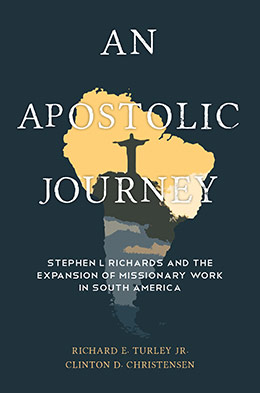Argentina
Richard E. Turley Jr. and Clinton D. Christensen, "Argentina," in An Apostolic Journey: Stephen L. Richards and the Expansion of Missionary Work in South America (Religious Studies Center, Brigham Young University; Salt Lake City: Deseret Book, 2019), 9–74.
Historical Background
The SS Argentina wended its way around the bulge of South America, making brief stops in Brazil and Uruguay before concluding its journey in Buenos Aires, often described as the “Paris of South America.” First on the Richardses’ mission-tour itinerary was the Argentine Mission—heir to the South American Mission founded in 1925 by Elder Melvin J. Ballard. The ensuing two decades of Church expansion brought membership to nine hundred, with most Argentine Latter-day Saints being of Italian, Spanish, and German descent. During that early period, new branches of the Church emerged from the major cities throughout the country.
Notwithstanding a grueling schedule and traveling twenty-six hundred miles by car during February 1948, Elder Richards encouraged members and missionaries and witnessed the baptism of a family in Argentina. He also made time to meet the media and strengthen the image of the Church. Active in civic groups like the Rotary Club, the Apostle also delivered speeches at the invitation of businessmen during his stay.
The Documents
Besides Sister Richards, the principal authors reporting on the Argentina trip were Howard J. Marsh, the mission secretary, and Argentine Mission president Ernest W. Young. Quite a few local newspapers also carried the story of a Latter-day Saint Apostle arriving in South America, capturing Elder Richards’s views and shedding light on perceptions of the Church in 1948. In the glow of the pro–North American era following World War II, Latin American news writers were favorable toward the Church and sought to accurately explain its teachings and beliefs.
Interspersed in the next chapter are letters and journal entries of missionaries thrilled at the opportunity to have an Apostle visit them and meet the members. Periodically, Elder Richards corresponded with the First Presidency, giving them informative observations and remarking on the status of his health; some of this correspondence has been reproduced herein. Also included are articles that the South American missions mailed to Salt Lake City so the Church News could keep its readers updated on the nature and impact of the Apostle’s visit.
BUENOS AIRES, ARGENTINA
Tuesday, February 3, 1948
Daily Summary
Arrived in Buenos Aires, met by President and Sister Ernest W. Young of the Argentine Mission, photographed and interviewed by reporters
Elder Howard J. Marsh, Argentine Mission Historical Report[1]
Elder Stephen L. Richards and his wife, Irene Merrill Richards, arrived this morning aboard the Moore-McCormick passenger ship “S/
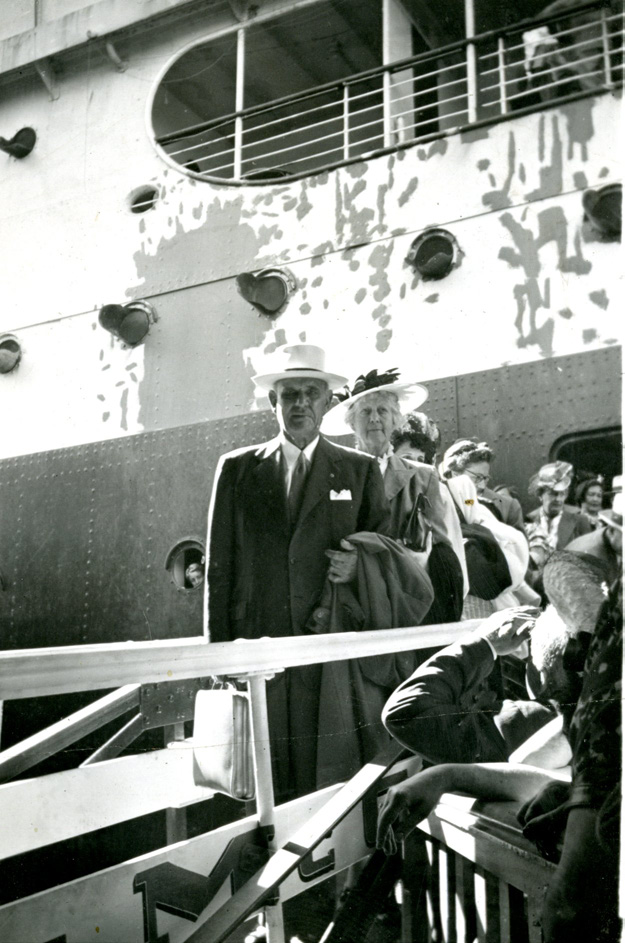 The Richardses' arrival in Buenos Aires, Argentina. Courtesy of CHL.
The Richardses' arrival in Buenos Aires, Argentina. Courtesy of CHL.
After a two hour delay in the aduana (customs house), Elder and Sister Richards were allowed ashore without any future difficulties. On the way home a stop was made at the Moore-McCormick agency, where negociations were made, although not confirmed, for Elder Richard’s return aboard the “S/
After lunch and a brief rest Elder and Sister Richards were interviewed by a reporter from “LA CRÍTICA.” The evening was spent in recuperation from “the exasperating ordeal” of the aduana, and in formulating plans for the rest of the visit.
Newspaper articles, plus photos, appeared in the evening editions of LA RAZÓN,[2] which was slightly unfavorable in vein, LA CRÍTICA,[3] which was quite favorable, and NOTICIAS GRÁFICAS,[4] which was just a brief announcement of the arrival.
News Article: La Crítica[5]
Apostle Richards
Apostle Richards has a venerable appearance, adequate to his elevated dignity. Scant in his declarations to the newspapermen, he expressed only that he had come to pass his vacation in Argentina and that he will observe the work of the various members of this religion, which number in the world more than a million initiates and was founded in 1830, in the United States by Joe Smith, prophet of the revelations from a celestial spirit, Moroni, who in life was the son of the last prophet of the ancient Americans, called Mormon, who arrived to this continent with the Jaredites several thousand years ago.
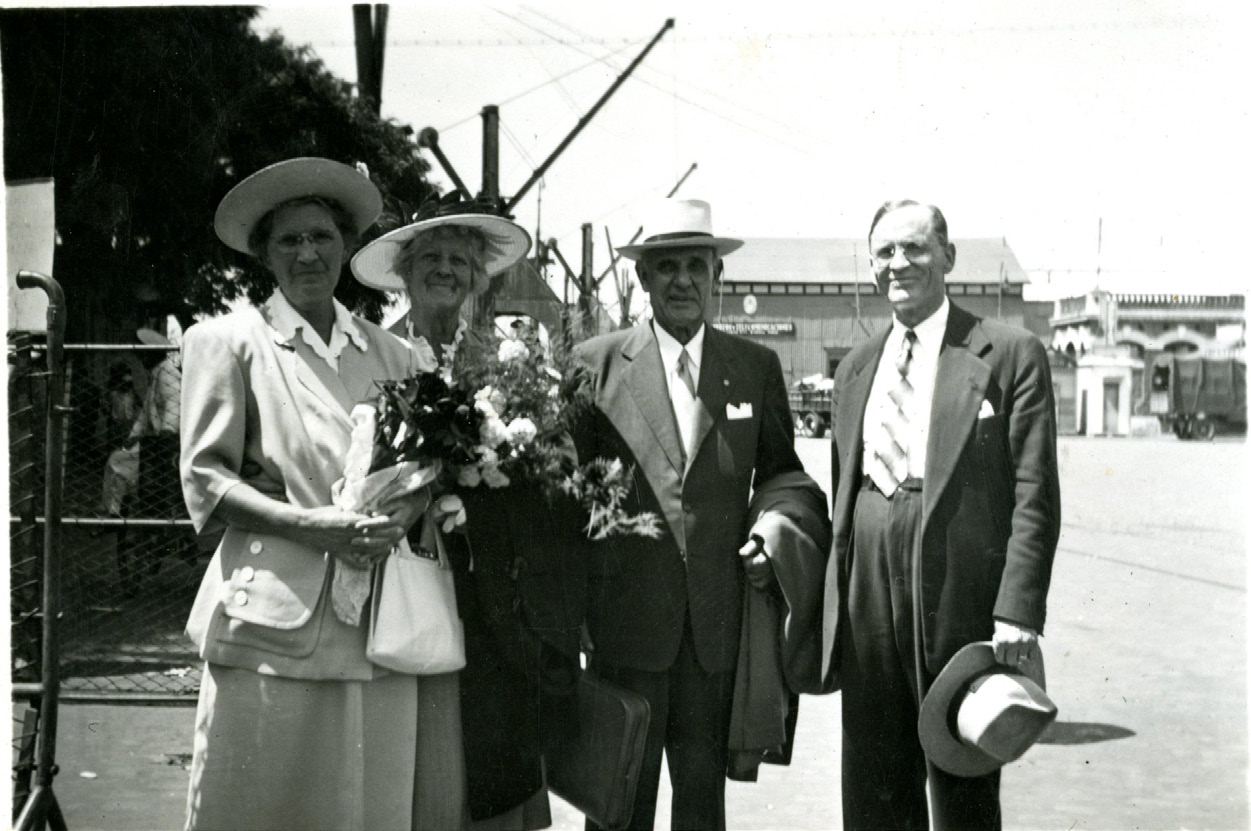 Stephen and Irene Richards with W. Ernest and Cecile Young, February 3, 1948. Courtesy
Stephen and Irene Richards with W. Ernest and Cecile Young, February 3, 1948. Courtesy
of CHL.
As you know, more than fifty years ago the Mormon Church excluded from its members the customs of polygamy. From Salt Lake City, Utah, the creed has extended to all parts of the world because of the work of its numerous missionaries.
In our country, relatively a few years ago, two hundred young Mormons established twenty-one missions.[6] Actually, in Buenos Aires the Mormon religion numbers more than a thousand members.
The Mormons, who believe in God, in Jesus, and the Holy Ghost, do not dress in ecclesiastical clothes nor adore images, flee from pomp and ostentation, and understand how to interpret, with simplicity and kindness, the Christian precepts contained in the Book of Mormon, which they do not consider in opposition to the Bible, but complementary.
They live a life healthful and natural. They practice sports, diffuse their teachings and beliefs. They abstain from tobacco, coffee, tea, and alcoholic drinks, and they live in accord with the norms that promise on the average an existence of more than eight years longer than the average mortal.
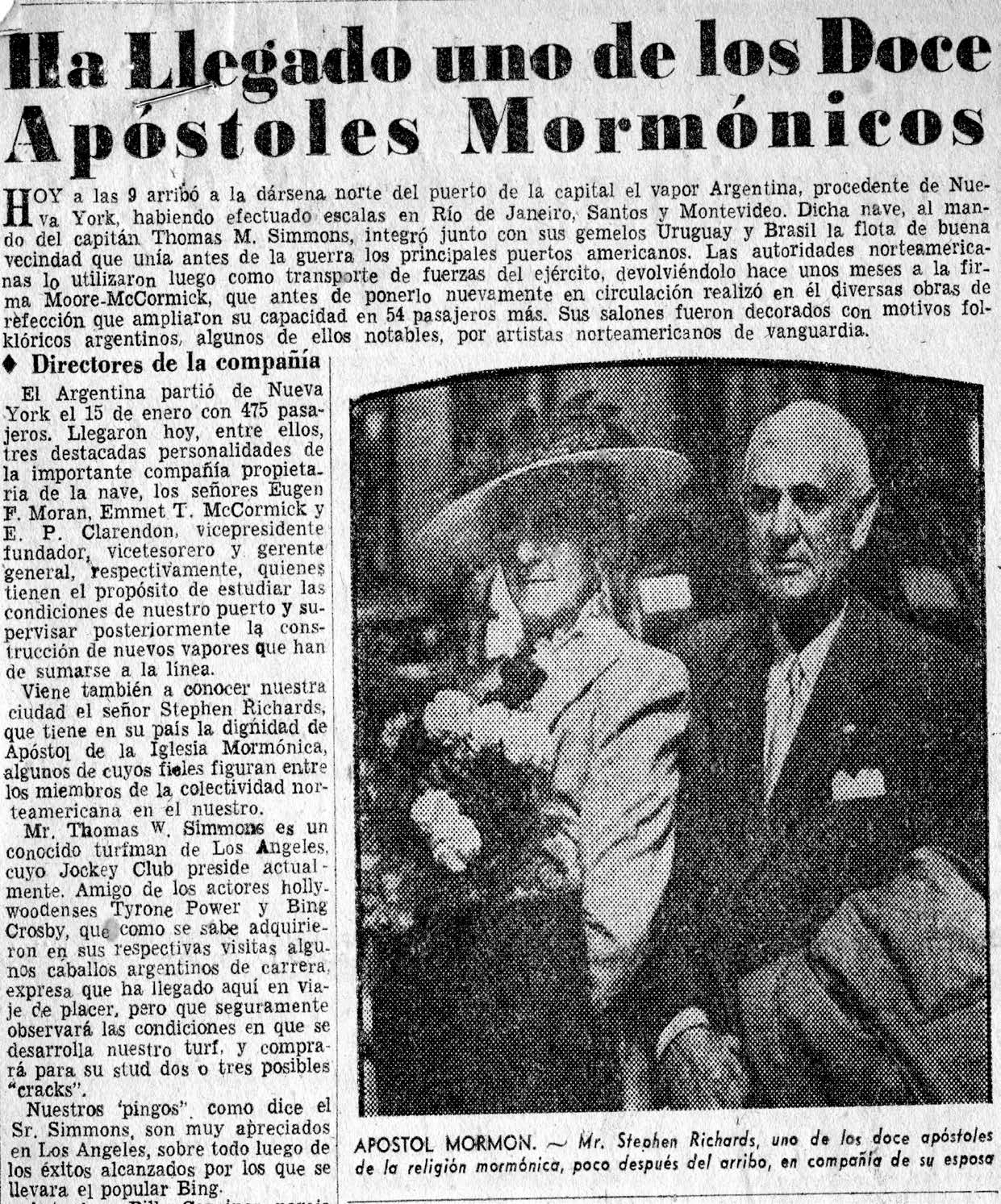 The Richardses' visit was covered extensively by news articles. Courtesy of CHL.
The Richardses' visit was covered extensively by news articles. Courtesy of CHL.
The creed is essentially spiritual and has for a purpose the betterment, dignification, and elevation of the conditions of humanity. Its faith and its noble goals remind of the words of Mahatma Gandhi,[7] “All the religions are good, because they are looking for the same God.”
BUENOS AIRES, ARGENTINA
Wednesday, February 4, 1948
Daily Summary
Lunched with the Rotary Club, shopped in the afternoon, and attended welcome social at the Liniers chapel
Irene M. Richards Letter[8]
Buenos Aires
Mission Home
Feb. 4, 1948
Dear Phil:[9]
So we are in the tropics. Bananas everywhere. The fields stretch from the roads out farther than one can see to the jungle. And it is a jungle, but these people are rapidly ploughing it up into productive land. The banana bush just produces one stick, then they are picked green and the plant cut down, and grows up again. There seems to be lots of fruit here but the potatoes are scarce and expensive.
All the ports were beautiful, tall white houses, lovely beaches, parks, and statuary especially artistic. I suppose our America is still young in art. This is so delicate and expressive.
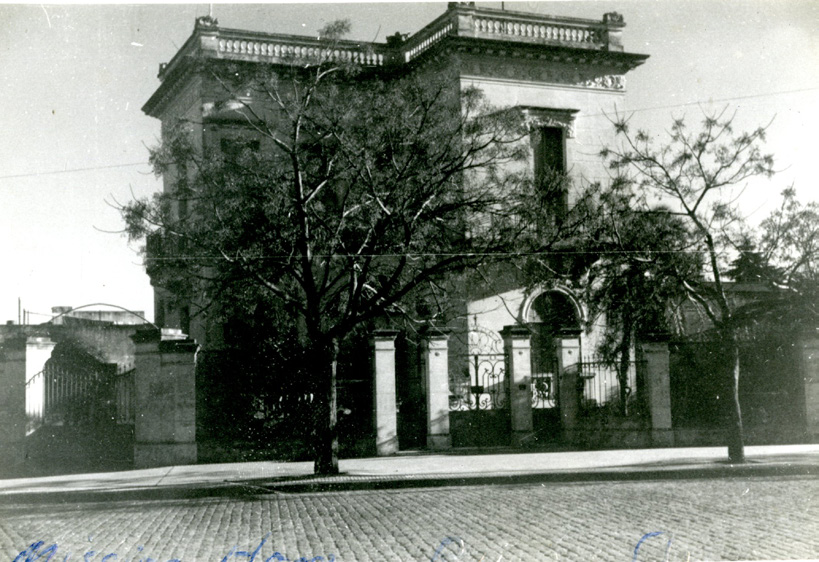 The Argentine Mission home. Courtesy of CHL
The Argentine Mission home. Courtesy of CHL
It was a thrill to dock and leave each time. Hundreds of people all pursuing their own ways. Coming and going, and greeting and saying good-bye. It is fine how good we feel when we spy some missionary looking for us. We can usually pick them out in a crowd. Sister Young had a beautiful bouquet of flowers for me. But before we could meet they were pretty well faded. We were three hours going thru the customs. Just because there were so many coming off the ship for Buenos Aires. But we were photographed and appeared in the headlines along with the McCormack President and I think he is sorry he didn’t invite us to his dinner on the boat today, after he found out how important we are!! Sour grapes.
Well, everyone is so kind to us, and anxious to meet Papa. Tonight there will be a party of greeting for him, here in Buenos Aires, by the saints. Now he has gone to a Rotary luncheon and to meet some of those Bankers whose friends are Orval Adams and the New York City Bank, etc. At every port someone from the Bank has met us and extended a wish to be of service to us. Good will for our church, I guess.
On arriving here we have a letter from Allie, Dick and Louise,[10] and we expect others soon from you all. . . . We are fine.
Love from,
Mother and Father.
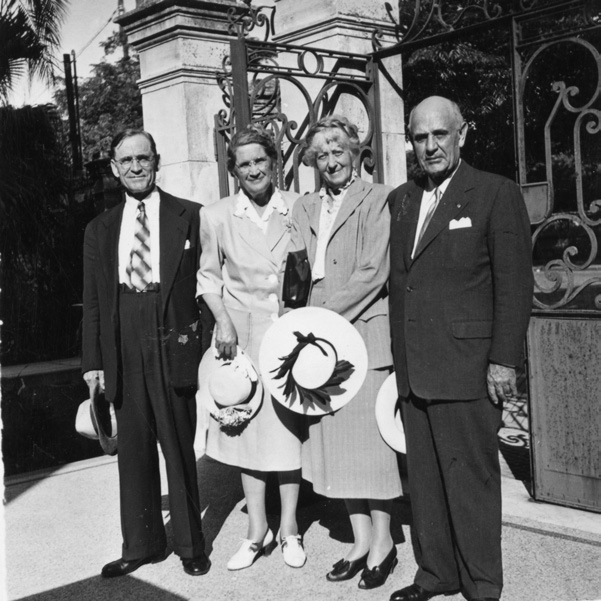 The Richardses and the Youngs (pictured on right) in front of the Argentine mission home.
The Richardses and the Youngs (pictured on right) in front of the Argentine mission home.
Courtesy of CHL
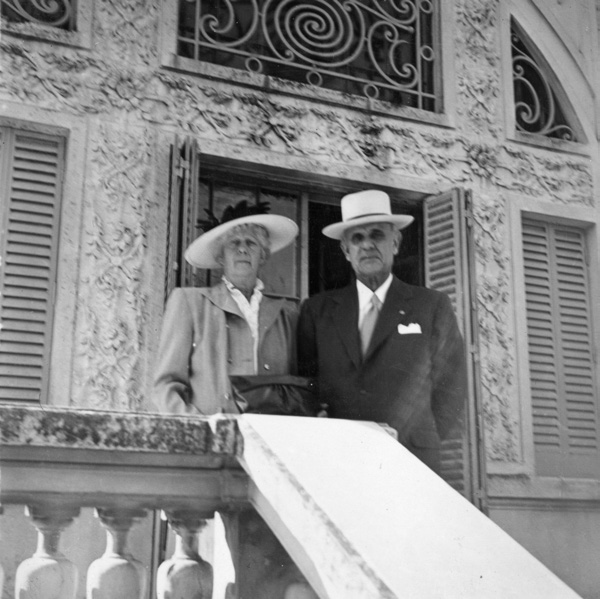
Irene M. Richards Letter[11]
Mission Home
Feb. 4, 1948
Dear Allie:[12]
We have finished our water travel for a while and the land still keeps coming up to meet us. Buenos Aires is also a pretty harbor, but the river water is red like the Colorado and the surrounding soil. The houses, mostly (apartment) along the beaches are new and quite severely modern. Papa has gone to a big hotel to Rotary Lunch and to meet some Bankers. Now, don’t laugh. I am washing and ironing. But the servant at the mission won’t let me do much, so I am really writing some letters. Your letter was one here to greet us. Thanks for it gave us a thrill from you so far away. Glad you are well.
We were three hours going thru the customs yesterday, unnecessarily. When will we all speak one language and treat each other like neighbors?
It was good to meet the missionaries and so many from home. Richards, Smiths, Biglars and Harvey Glade, our home neighbor, who is one of the winning basket ball team. There are half a dozen silver trophies here in our room won by our boys. They gain attention that way and make friends and enemies, I guess.
The mission home is a typical Spanish home, once elegant, now somewhat run down. If it were furnished and renewed I would love it, a very decorative exterior, with high wall and iron gates and fence, a beautiful garden, wonderful pines and shrubbery. Paved walks in tile, balconies and patio in tile. Marble floors, tall doors and windows and ceilings out of sight. With Spanish furniture, drapes, lamps, etc., it would be gorgeous. But it is not practical and the plumbing is no good. So I wish they could have a modern, no architectural pattern but convenient place like the President in Montevideo has. These beautiful old places are being replaced by ugly modern stuff very fast.
The beaches are crowded right now and it is really hot, but tomorrow they say it may be cool. We are going to attend a greeting party for Papa here tonight. I hope he won’t be too tired when he gets home. We are fine and interested in what we are going to do next. Will try to drop a card or note as often as possible.
The statuary here is superior. All done in Italy I presume. The high class is ultra. I enjoy it all and am seeing things that Pap[a] doesn’t because he is wrapped up in his work. Keep well and we know your garden will be lovely for Knight’s[13] efforts.
Lovingly,
Mother and Father.
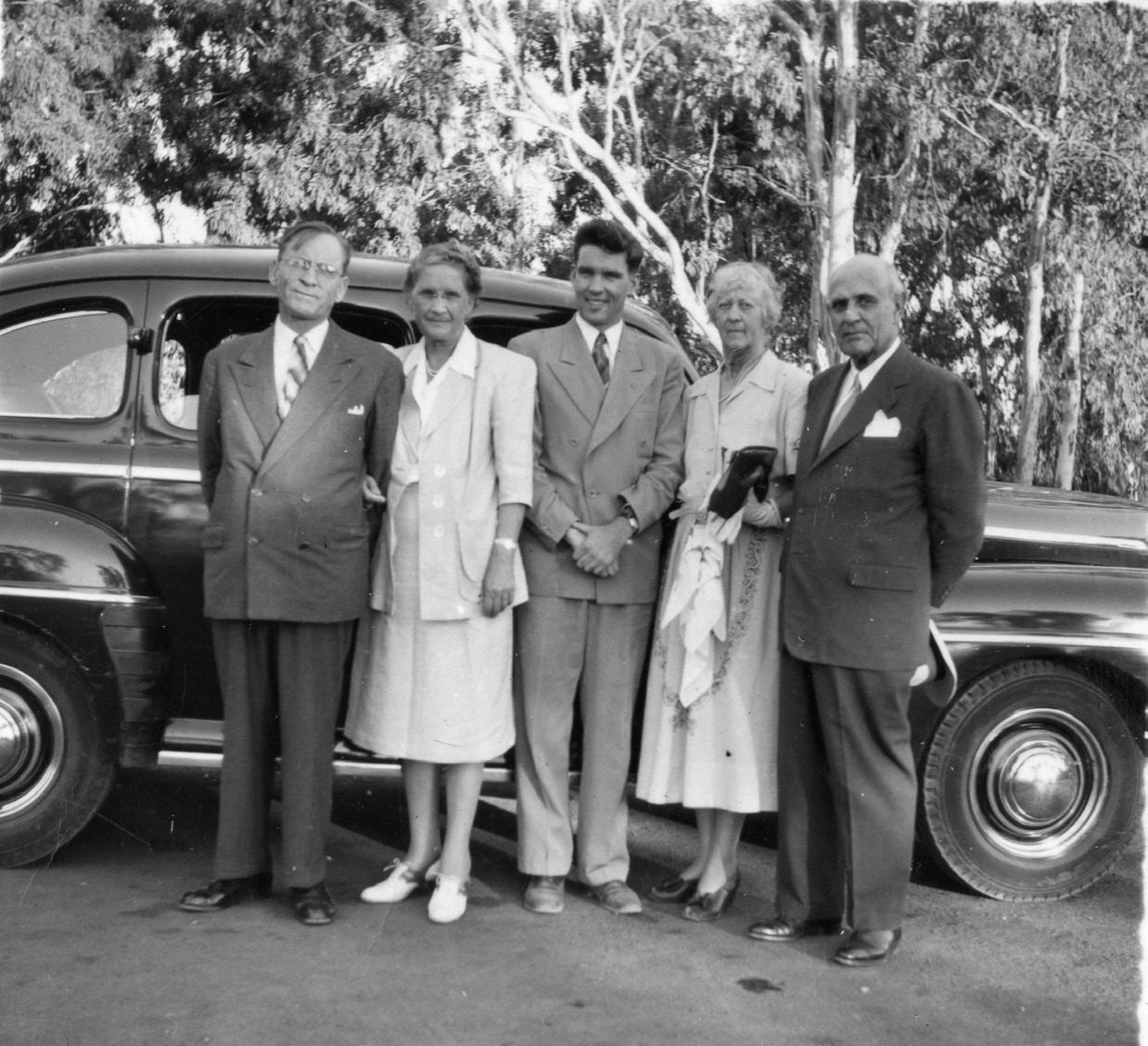 Howard J. Marsh, the mission secretary (middle), traveled with the Youngs and Richardses
Howard J. Marsh, the mission secretary (middle), traveled with the Youngs and Richardses
throughout Argentina. The Church News caption for this photo stated they “Drove 2,600 miles of country roads” in this car. Courtesy of CHL.
Elder Howard J. Marsh, Argentine Mission Historical Report[14]
At noon the President and Elder Richards dined with the local Rotary Club at the Plaza Hotel.
The afternoon was spent in “window shopping” on Florida Street.
At night the official “Bienvenida”[15] was held in the Liniers chapel. The program started at 8:15 p.m., and lasted until 10:05. . . .
There were 353 in attendence, and a deep spiritual influence was felt. The audience was especially appreciative of the fact that an Apostle could laugh and enter so thoroughly into the festivities. In his remarks Elder Richards expressed his thanks for the welcome rendered and dwelled for a short while on the theme “the Gospel makes brothers of us all.”
The translation done by Elder Young followed in rapid order so that not one iota of the meaning or feeling was lost to the audience.
Many of the Saints in attendance were priviledged in meeting Bro. and Sis. Richards after the meeting.
Many of them expressed the idea that “tonight heralds a new future for the Argentine Mission.”
Newspaper articles (all favorable) appeared in today’s editions (all of them accompanied by photos) of LA CRITICA, CLARIN, DEMOCRACIA, STANDARD, HERALD, and EL MUNDO.
News Article: La Crítica[16]
Mormon Apostle, Who Has Just Arrived in Buenos Aires, Admires Gandhi
Caption: Sent from God—Stephen Richards, one of the twelve apostles of the Mormon sect, who has just arrived in our capital, spoke to LA CRÍTICA on the mysteries of the order over which he presides, and he demonstrated a sincere admiration of Gandhi,[17] who—he expressed—defended the peace of the world in his own way.
Very few inhabitants of this immense Buenos Aires know that in a moderate “petit-hotel” in the burrough of Flores, behind the rusty gates which lead into a small garden, is the seat of episcopal power of the “Church of Jesus of the Latter-day Saints”, better known by the masses by the name of the “Mormon Sect.”
Nothing in the house indicates that its occupants could render tribute to a religious faith. It appears more like a commercial office, with its necessary typists and its employees in charge of the books. Not a single symbol. All is internal and dwells in the hearts of these men and women; serene, gentle, and affable, who speak of the revelation of their miraculous book with a contagious security.
We went there in search of one of the twelve Apostles of the church, Stephen Richards, in order that he might illuminate us on the secrets and mysteries of the order over which he presides.
With the Apostle
Apostle Richards arrived yesterday morning aboard the steamship Argentina. We must sincerely confess that his apostolic profession made us feel as if we were in the presence of a man who had something in common with those who are usually found in the common fantasies about a man who is in permanent contact with divine powers. Perhaps it was his dress, perhaps the visage, perhaps the amazement of a strange doctrine. None of these: Richards is a common man, plain, without appearances which would distinguish him from any ordinary North American of average excellence. This yes, stripped of all pretense in his manners, and placed on the same plane as the interlocutor, even though the writer was not born under the starry flag.
Apostle Richards received us in one of the offices of the “Church of Jesus Christ of the Latter-day Saints,” in the midst of the hustle of the place. With him was the President of the Argentine Mission, W. Ernest Young, and the wives of the two.
Let us now listen to the smooth-flowing serene words from the lips of a man sent from Christ.
—I have visited Brazil, Uruguay and now Argentina.[18] I am very satisfied with the work of our missions. The work in Argentina dates from 1925, it is the longest established, and I will dedicate the largest part of my time to it. I will tour the country and come into contact with my brothers.
The Book of Mormon
Our church—continued the apostle—is absolutely separated from politics. We honor and obey the laws of all countries. We respect, likewise, all religions. Our object is to extend the doctrine of Christ in the world, and we do not maintain ties with other churches.
We asked apostle Richards to explain his doctrine. He replied—
—Our doctrine is founded on the “Sacred history of the ancient Americans”, compiled by the Apostle Mormon some 1500 years ago, and discovered in the north of the State of New York in the year 1823, on some plates of gold, during dome [some] archeological excavations. It was written in refined Egyptian, and already has been translated into the majority of the languages. The first part of the Book of Mormon corresponds to the Bible, since the origin, unto the time of Isaiah, 600 years before Christ, and later continues with the American part.
We inquire—With the American part?
—Yes, because 600 years before Christ there was an emmigration of Hebrews from Jerusalem to South America. Here they established and founded a civilization very superior to the one which the Spaniards encountered during the epoch of discovery. Later they passed to Central America, and from there to North America, where internal wars consumed them until they disappeared. The Hebrews, on emmigrating to our continent, brought the Bible printed on plates of bronze. Mormon continued the American relation. And in his book he transmits the following message to the Americas: while you obey the laws of Jesus Christ you will prosper and be free forever.
—Could Mormon have known of the existence of Christ?
—His “history” demonstrates that he did. The archeological proofs are irrefutable.
The Greatness of Gandhi
The Apostle preferred not to talk of international politics. Nevertheless, before saying farewell, we asked him this question.
—What do you think of the assassination of Mahatma Gandhi?
—We have lost a man of God. He defended the peace of the world in his own way, in a manner highly peculiar.
And the man sent from God extended his hand and awarded us with a smile full of kindness and condescension.
Trans. by Elder H. J. Marsh
Elder Howard J. Marsh, Unpublished News Article[19]
Buenos Aires-----February 5, 1948
. . . Upon their arrival (Tuesday morning February 3rd.) Brother and Sister Richards were the recipiants of a semi-formal welcome on the part of a small group of the local brethern. The official reception was held that night in the chapel at Liniers (the only church owned and built chapel in Argentina).
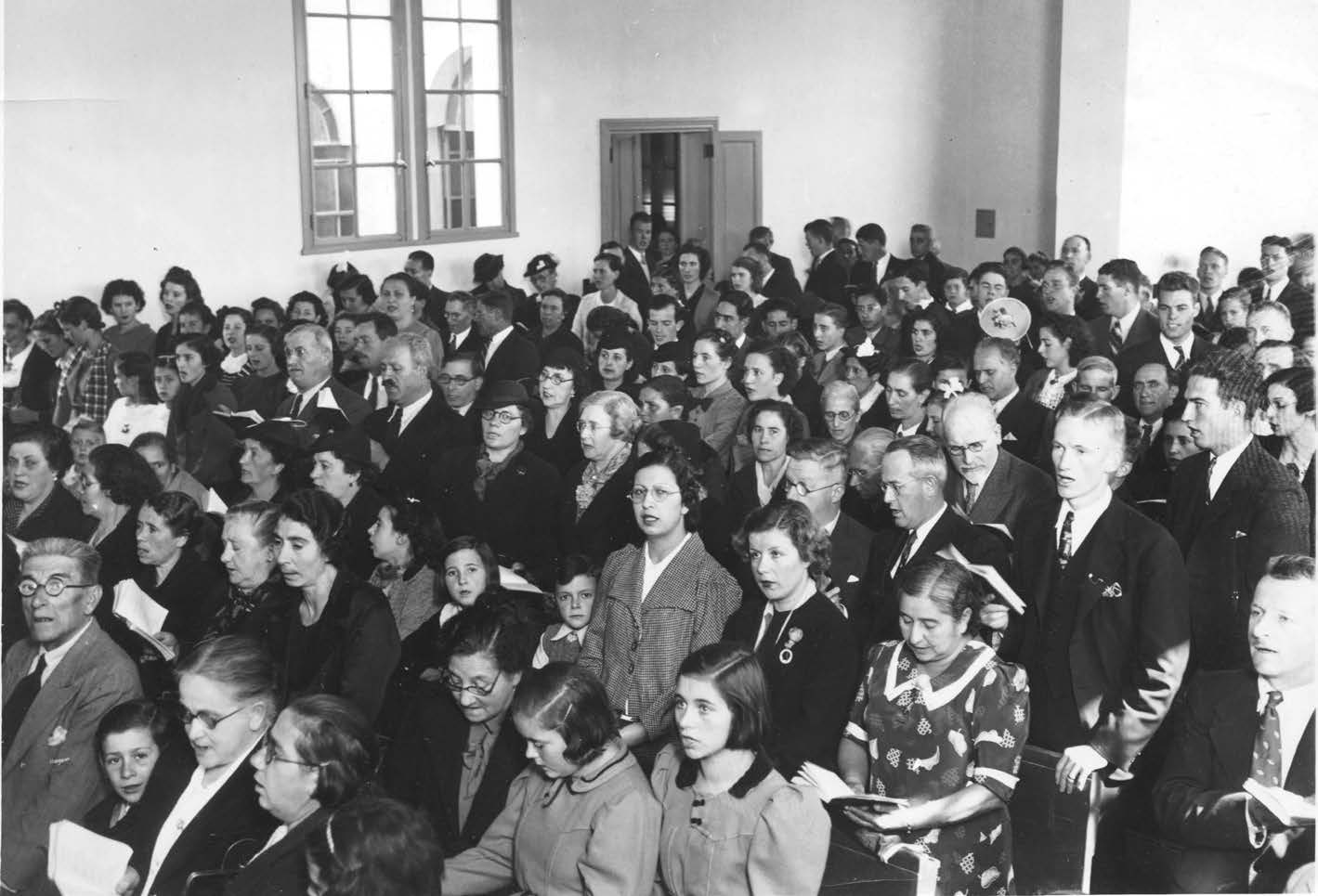 Liniers chapel dedication, April 9, 1939. Courtesy of CHL.
Liniers chapel dedication, April 9, 1939. Courtesy of CHL.
Stretching the normal seating capacity of 300 to a number somewhat higher than 350, the large audience was highly pleased by the congenial spirit evidenced by Brother and Sister Richards. His infectious smile won the hearts of all—the majority of whom had come expecting to see a man of overpowering sobriety. (If this is hard to picture; remember that the visit of Elder Richards is the first visit of an authority of the church since the mission was dedicated in 1925, for this reason few of the local brethern had ever seen an general authority.)
During the program of “bienvenida” (welcome), which consisted in large part of native songs and dances, Elder and Sister Richards were presented with flowers and similar tokens from the local sisters.
In addressing the audience, through the interpretive ability of President Young, Elder Richards dwelled shortly on the theme “the Gospel makes Brothers of us all.”
The feelings of all who were present is perhaps best typified by this remark which was voiced by several—“this night marks the beginning of a new era for the Argentine Mission.” We all feel this deeply, that the Argentina Mission has finally outgrown its infancy, and has become of age. We trustfully look forward to a future period of increased missionary activity, reaping its harvest as it must.
This Sunday (February 8, 1948) a special conference will be held in Buenos Aires, after which Elder Richards plans to depart for a two-week inspection trip through the interior of Argentina.
Elder H. J. Marsh
BUENOS AIRES, ARGENTINA
Thursday, February 5, 1948
Daily Summary
Visited the Florida Branch, shopped, met with bank executives and businessmen
Elder Howard J. Marsh, Argentine Mission Historical Report[20]
Elder Richards, accompanied by his wife, Bro. and Sis. Young, and Elder H. J. Marsh visited the Rama[21] of Florida in the morning. The afternoon was spent in the central part of town—shopping and establishing amicable relations with various men of importance in the financial and business world (First Nat’l Bank of New York). Rested at night. (i.e. the Apostle rested)
BUENOS AIRES, ARGENTINA
Friday, February 6, 1948
Daily Summary
Wrote letter to the First Presidency about arrival and attended opera in the evening
Irene M. Richards Letter[22]
Mission Home
Buenos Aires
Feb. 6, 1948
Dear Lois and Louise and all:[23]
I think you see each other often and I am rather crowded just now for time. We are getting more involved every minute. They are holding a conference here and there are about 200 members and there will be 50 missionaries to meet. It takes a long time to hear each one, and that’s the only real way to get to know how they feel and their plans and aspirations. One can usually read their spirits and dispositions. It is very interesting. We are in the old section of town, a very romantic setting. I expect to see a pretty Senorita coming out of her gate, or peeping out of the iron fence in her garden. . . .
. . . The press was sensational, but after interviewing Papa they spoke better of the Mormons. Evidently there is a lot of ignorance about, but everyone is interested in U.S.A.
The branch gave us a real welcome and flowers, a cake, sweater for Papa made by Relief Society sisters, etc. This town is beautiful and I have some pictures to bring home of it. Last night we went to hear “Butterfly”[24] given in an open air stadium. The singers, all Italian, were lovely and the setting enchanting. We sat on the last row but they let us down at the last act to the front, for which Papa was disappointed because it brought him down to realities. I was glad to see the costumes close, but it made the players fat. We are fine. Hope you all are. Thank you for your lovely letter.
Lovingly,
Mother and Father.
Stephen L Richards Letter[25]
Dear Brethren:
On arrival here, I have sent you a cablegram, “Arrived, well, notify folks.” We have received the most generous welcome, and I am sure that we are among a most hospitable congenial people.
We will begin holding conferences tomorrow. Our schedule takes us through all the districts and most of the branches of the mission. When we have made the tour we will be in a better position to crystalize our observations.
We are in good health and the report is that all the missionaries here are also. I will be glad to keep you advised of any items of moment. We hope that this will find you all well.
Faithfully and Affectionately yours,
____________________________[26]
SLR/
BUENOS AIRES, ARGENTINA
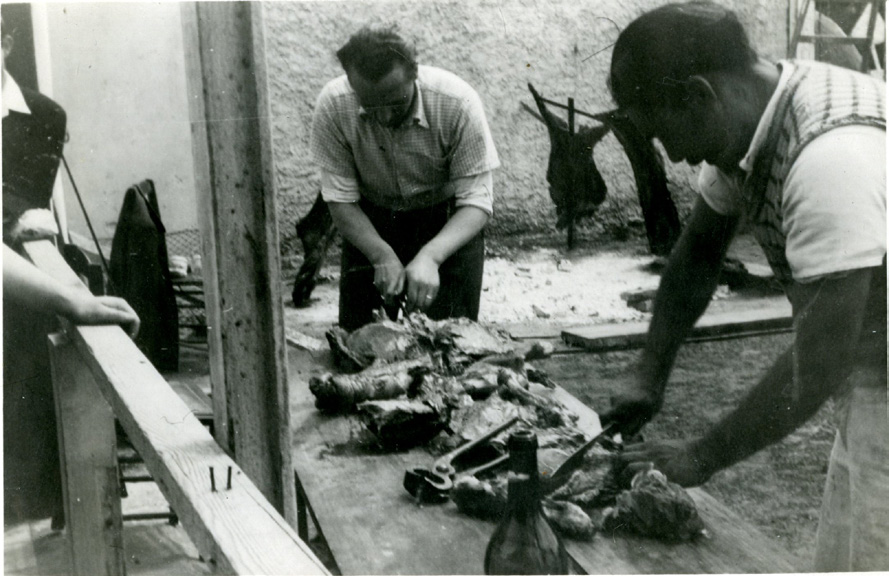 Members prepare an “asado,” a feast of meat. Courtesy of CHL.
Members prepare an “asado,” a feast of meat. Courtesy of CHL.
Saturday, February 7, 1948
Daily Summary
Missionary conference at Liniers
W. Ernest Young, Argentine Mission President[27]
February 7 a missionary report and testimony meeting was held for all elders in the Capital area at the Liniers chapel. There were forty-nine present including Elder and Sister Richards and Brother and Sister L. Pearce [Pierce] Brady.[28] The first session was at 10:15 a.m. and ended at 1 p.m., given for reports and testimonies. The second session began at 3:05 p.m. and ended at 7 p.m. with more reports and testimonies. After a ten-minute recess the meeting time was given to Elder Richards, who elaborated on the following subjects: (1) Missionaries must adapt themselves to the different conditions in this field. (2) In this Church, the right of nomination has been given to the President of the Church. (3) He admonished all to follow the counsel of the Authorities. (4) The missionary responsibility is to present the gospel in such a manner so that the recipient of the missionary’s message may be judged as having accepted or rejected it. After the meeting the missionaries went to the mission home where “North American” refreshments were served.
BUENOS AIRES, ARGENTINA
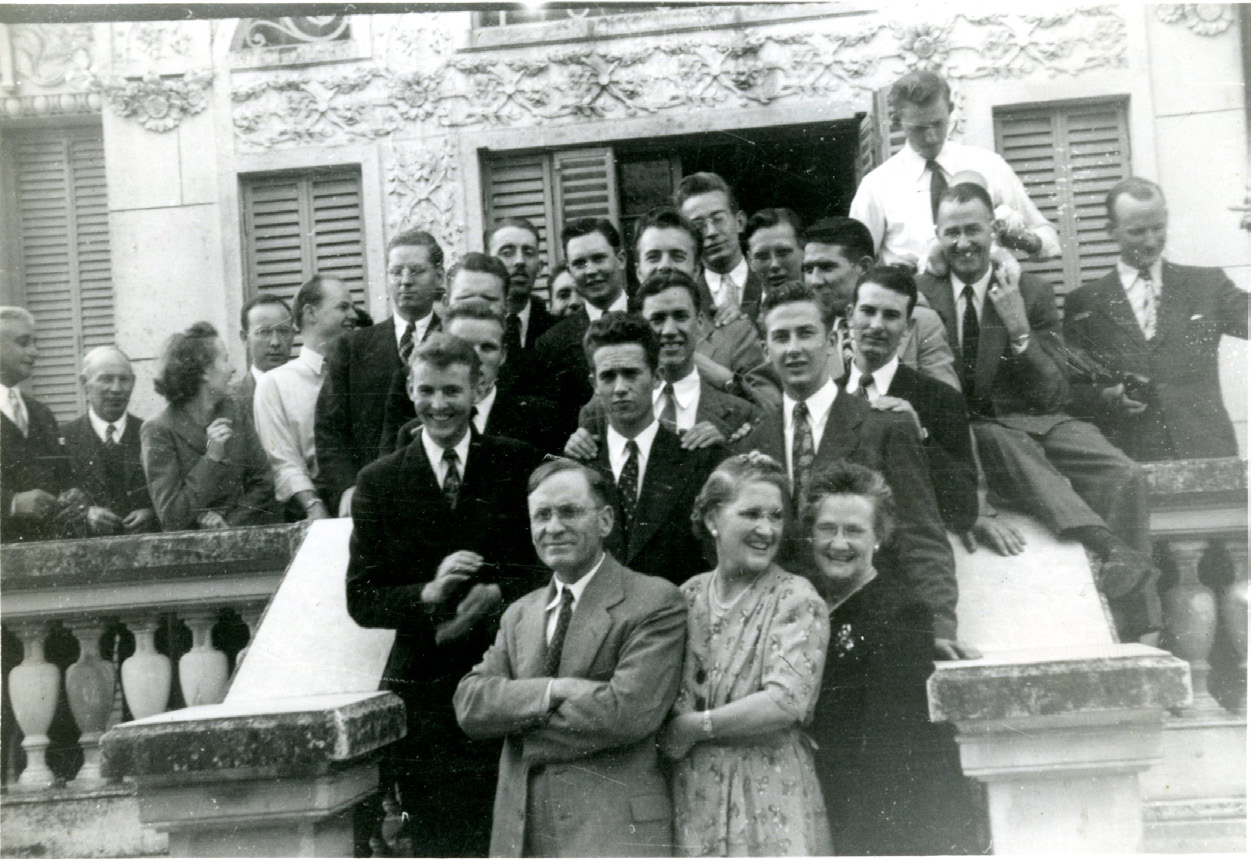 Mission conference, March 1947. Courtesy of CHL.
Mission conference, March 1947. Courtesy of CHL.
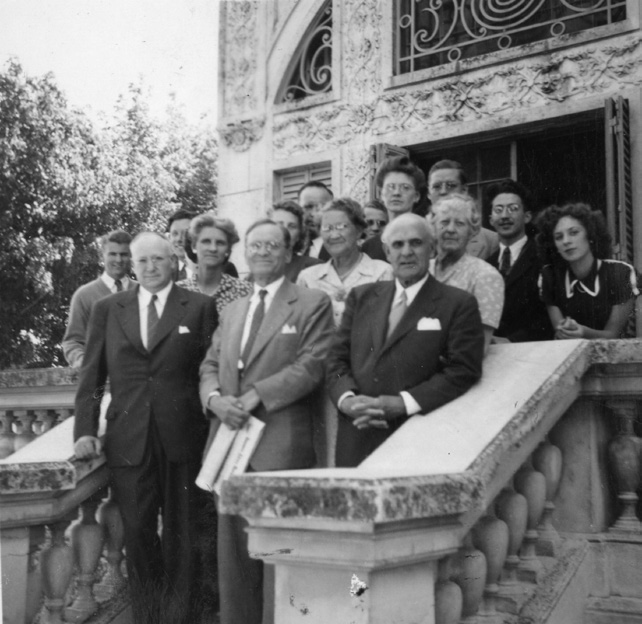 Meeting of mission presidents and missionaries,
Meeting of mission presidents and missionaries,
with Frederick S. Williams, W. Ernest Young,
and Stephen L Richards in the front row and
their wives standing immediately behind them.
Courtesy of CHL.
Sunday, February 8, 1948
Daily Summary
Conferences at the Liniers, Ramos Mejía, Haedo, and Ciudadela Branches
Elder Howard J. Marsh, Argentine Mission Historical Report[29]
Feb. 8, 1948. 8:30 a.m. attended priesthood meeting in Liniers. Elder Richards spoke on the theme “You have the responsibility of advancing yourselves in the priesthood so that you can receive the higher blessings.” The party then proceeded to Ramos Mejía.[30] Elder Richards’ theme—“The pure and simple spirit—the essence of the true Gospel of Jesus Christ.” Then to Haedo.[31] Elder Richards spoke of “Participation in the work of Christ brings happiness. Lack of participation brings sorrow to the soul. Death is a part of the plan, not to be feared, but we look forward to the reunion of our loved-ones in the hereafter. We fear sin because this could keep us out of the happiness of the heavens.—One-third of the world now profess Christianity, but don’t know Him very well—our duty is to teach them the true Gospel—the stone (of Daniel’s dream) has started to roll. Testimony of Elder Richards.” And lastly of all to the Ciudadela Branch,[32] where the theme of “Save the Children first”, was developed.
At night a special district conference was held at Liniers. 338 were present.
TRES ARROYOS, ARGENTINA
Monday, February 9, 1948
Daily Summary
Traveled to Tres Arroyos and held conferences with missionaries serving in Tres Arroyos, Bahía Blanca, Tandil, and Coronel Suárez
W. Ernest Young, Argentine Mission President[33]
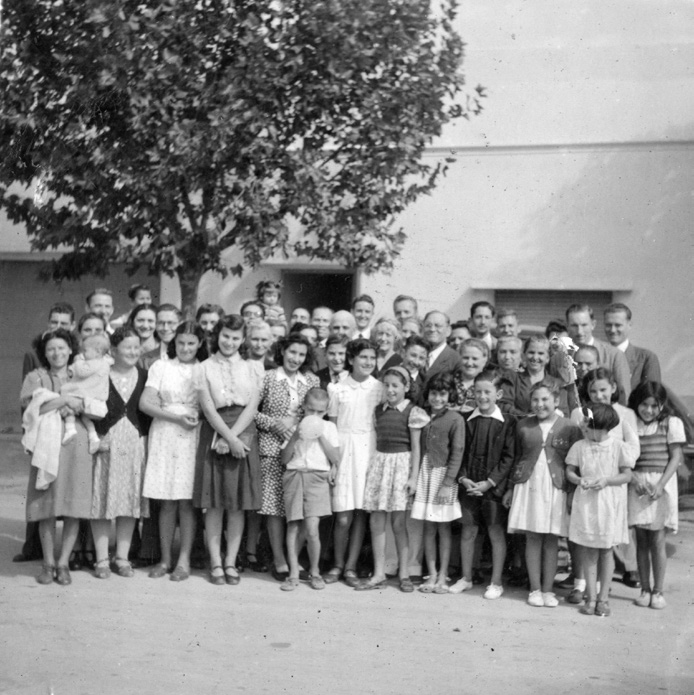 The Richardses visit the Ramos Mejía (left) and Haedo (right) Branches in Buenos Aires.
The Richardses visit the Ramos Mejía (left) and Haedo (right) Branches in Buenos Aires.
Courtesy of CHL.
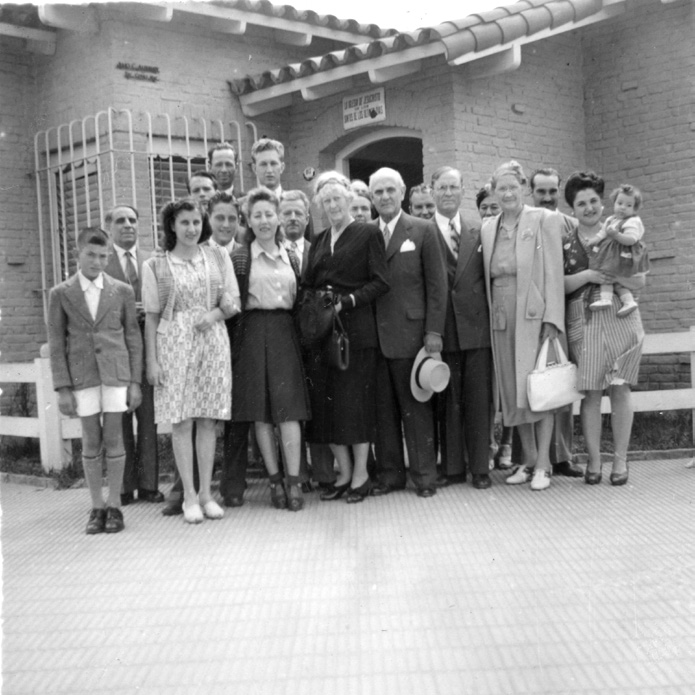
Visit to Southern Branches of Mission
February 9 Elder and Sister Richards, Cecile and I, and Elder Howard J. Marsh left early enroute to Tres Arroyos.[34] We arrived in mid-afternoon, and in the evening a missionary report meeting was held with the elders from Tres Arroyos, Bahia Blanca, Tandil, and Coronel Suarez.[35] As usual very good instructions were given to the missionaries, and testimonies and reports by the elders were good.
Elder Edwin J. Richardson Letter[36]
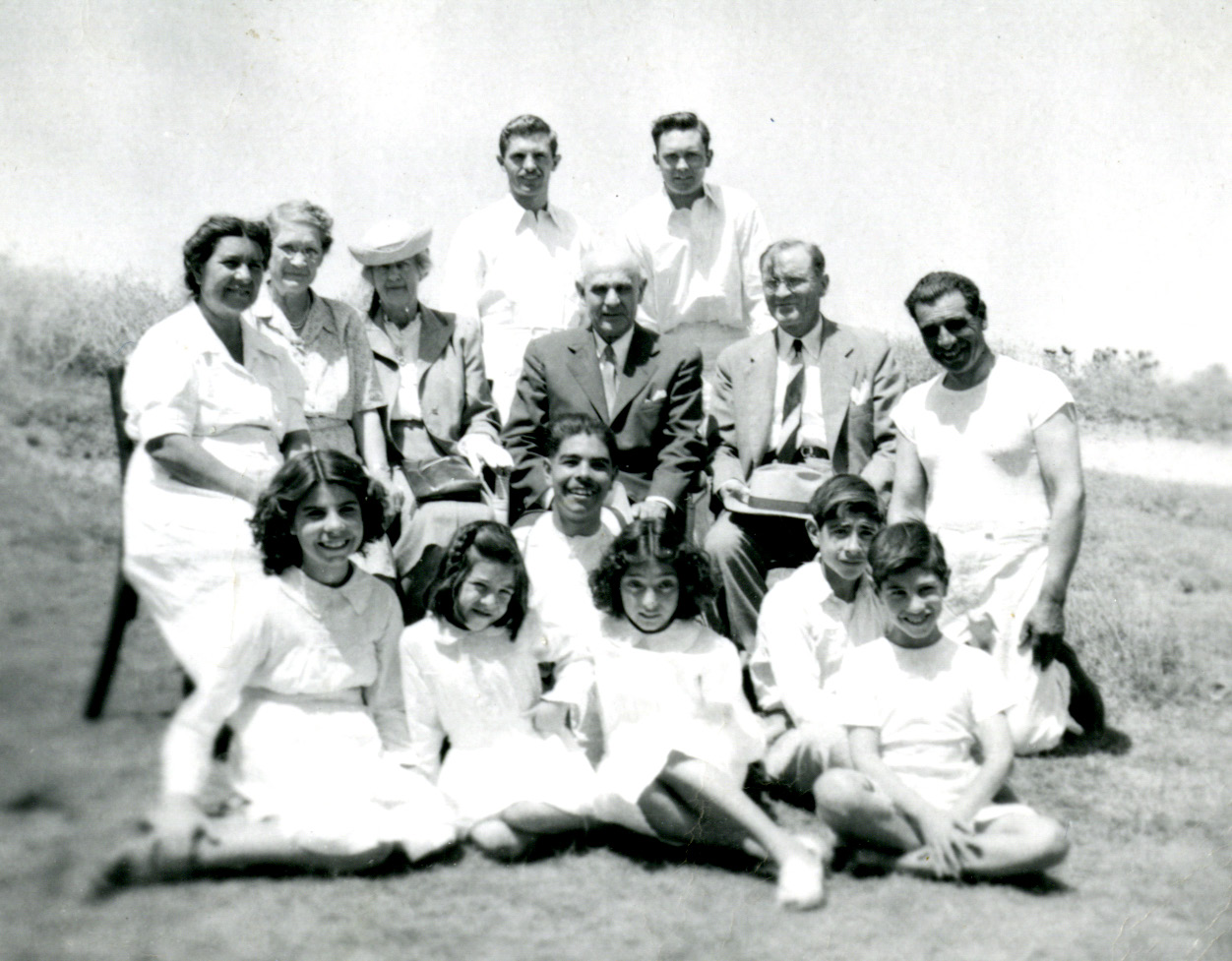 The Youngs and the Richardses sit with the Maldonado family and young girl who were
The Youngs and the Richardses sit with the Maldonado family and young girl who were
baptized. Elders Carroll and Marble are standing. Courtesy of CHL.
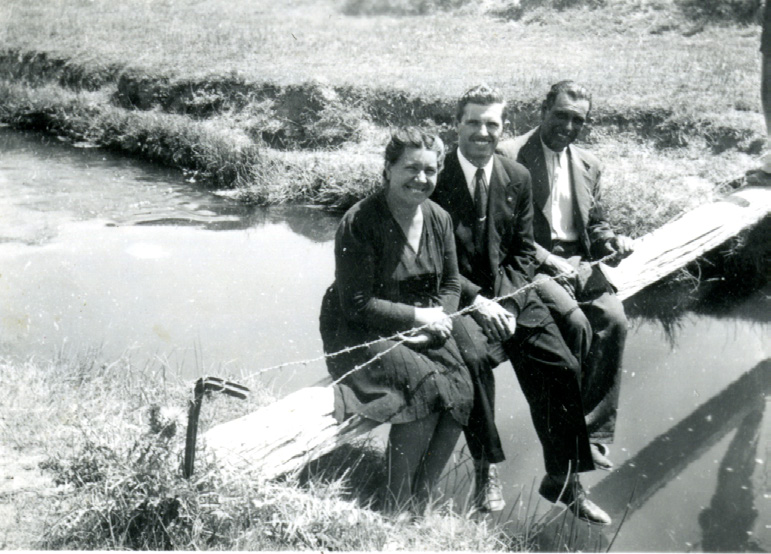 Brother and Sister Maldonado with Elder Carroll at the site of their baptism. Courtesy of CHL.
Brother and Sister Maldonado with Elder Carroll at the site of their baptism. Courtesy of CHL.
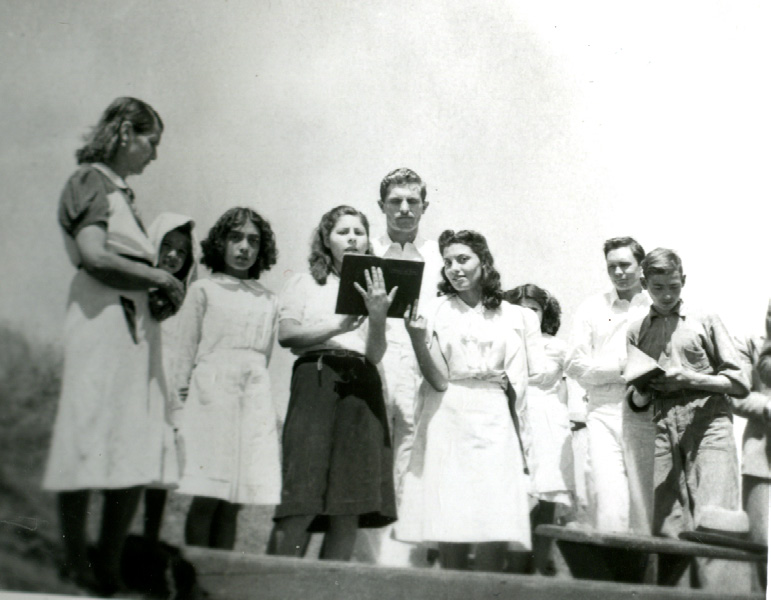 Musical number at the baptismal service. Courtesy of CHL.
Musical number at the baptismal service. Courtesy of CHL.
In Tres Arroyos there was nothing definitely planned so we had to wait till Pres. Young came at 4:00. Apostle Richards and his wife came too. They decided to hold the missionary meeting that night as two of the B.[ahía] B.[lanca] missionaries had to return the next morning for a picnic they had planned for the branch before they left. So the missionary meeting was held at 8:00 Monday night. These missionary meetings are the ones that are remembered longest by the missionaries. I think I told you about the one that lasted nine hours in the Capital (B. A.) last conference. Well, this one didn’t last quite that long, but it was really inspirational. Each one of the missionaries spoke, including Hno. Costantini who doesn’t understand any English and the meeting was held in English for the benefit of Elder Richards. Pres. Young translated Hno. Costantini’s talk into English for Elder Richards. Then Brother Looney, our member here in Bahia, gave the account of his conversion and his testimony. That meeting was the only part of the conference he could attend as his wife was sick and he had to be back the next day. But he felt very highly repaid for his trip, Having had the opportunity to see and shake hands with an apostle. And too, Elder Richardss he complimented him quite highly and thanked him for his testimony. Then, of course, Elder Richards was the last speaker. He gave us some very fine and timely instructions. He was tired from his trip and had talked in several meetings the day before in Buenos Aires, and so, as he said he had a lot to tell us but since he was under the necessity of guarding his health he could not tell all. Nevertheless he gave us some very good instructions.
TRES ARROYOS, ARGENTINA
Tuesday, February 10, 1948
Daily Summary
Baptism of the Maldonado family and evening member meeting
Elder Edwin J. Richardson Letter[37]
Tuesday about noon we all went out in the country a mile or so where there was a small creek where we could hold some baptisms. The Tres Arroyos missionaries have done a fine job in converting an entire family. Seven of one family, including both parents, and a young girl from another family were baptized and afterward confirmed on the banks of the stream. Elder Richards made the statement after witnessing all this, or rather asked the question: “Who knows but what in a hundred years there will be over a thousand members in the church descendents of this family?” Then he said that in a reunion in Utah of the descendents of a man who joined the church 100 years ago there were more than 2000 people, descendents of that man. This will be one of the high lights of my mission because I confirmed one of the members of that family.
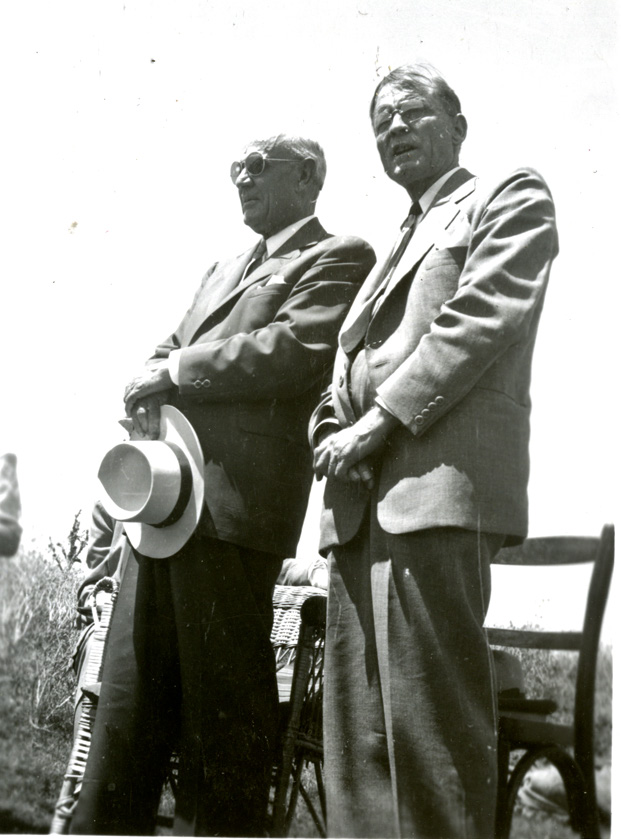 President W. Ernest Young translates for Elder Richards at the baptismal service. Courtesy of
President W. Ernest Young translates for Elder Richards at the baptismal service. Courtesy of
John R. Wall
The conference session, only one was held, took place in the back end of the lot of the Tres Arroyos branch in the open air. It was a little cool for Elder Richards bald head so the session didn’t last more than an hour and a half, but at that it was really worthwhile. Pres. Young spoke for about thirty minutes about the Apostasy, Restoration, the nearness of the Second Coming of Christ, a few other things pretty well linked together. Only one of the missionaries spoke and his was an extemporaneous speech. Elder Carrier gave a very humble testimony. Sister Young gave a few words and one of the member women from Tres Arroyos bore her testimony. Elder Richards talk of course came last and was the highlight of the Conference. He spoke of world conditions and the reason why they are in such a state, namely wickedness, lack of love for one another, greed and selfishness. Pres. Young translated for him. In that way we who had a knowledge of both English and Spanish got double benefit from the talk.
BUENOS AIRES, ARGENTINA
Wednesday, February 11, 1948
Daily Summary
Return trip to Buenos Aires and Irene’s reflections on missionaries and Argentina
Irene M. Richards Letter[38]
Buenos Aires, Argentina
February 11, 1948
Dear Ellen and Lloyd:
Having met your nephew[39] in this mission, inspires us to write a line to tell you how glad we were to discover he was yours. He surely is a fine Elder and is an inthusiastic and interesting as can be. He is well and very happy here. Its hard to understand just how much good a missionary can do here, until one sees them in action. We came upon them in Sunday School teaching the children in spanish. We attended a baptism where 6 or more were taken down into a clear stream by the Elders, heard them sing and preach in spanish. And we saw how they were regarded by the members of their branches. They stand out apart from the usual crowd. They are in very deed Saviors on Mount Zion.
Your boy is one of about 200 and an outstanding one. By the way he has a small mustache, which rather gives him distinction, and is becoming.
This is an entirely different country than ours, and it is hot summer now although it is cooler than usual they say. We traveled a distance of some 300 miles to meet this group, of missionaries. Tomorrow we are going in another direction to meet another group. And to hear them all speak and its a thrill to listen to their experiences and testimonies. They all say they have the best parents in the world, and I agree with them, and these parents have the best boys in the world.
There are no mountains in sight, just fields and meadows, some trees and hundreds of cattle. I have had some lovely bananas but no tender beef yet. I think they dont know how to cook here. I am sure the boys get along better doing their own cooking. There are lots of vegetables and fruit. I see melons but we have not tried them yet. I have not seen orchids yet. They say they are in Brazil.
The beautiful thing here is the tile side walks and floors. Everyone has them The patios and halls and walled in gardens are beautiful. Sometimes the boys can’t find places to rent on the paved streets though. The middle class of people are fine looking and intelligent. I am sure the missionaries are attracting attention. They are outstanding among these South Americans. They need equipment and all the help we can give them. This is a big rich land and some day it may be o.k. if it can arrange its politics to be a true democaracy. The Argentinae’s are envious and suspicious of North Americans and our boys have to convince them that they did’nt come to rob them, but want to help them. Weell, they seem earnest and willing to stand anything; so I’m sure they can succeed. Your nephew sends greetings and we do also. Hope all is weell with you.
Sincerely,
Bro. & Sister Richards.
Irene M. Richards Letter[40]
Buenos Aires, Argentina
Feb. 11, 1948
Dear Lynn:[41]
We have just returned from a trip to “Three Rivers”. I won’t attempt to tell it in Spanish.[42] . . .
On our trip we saw some ostrich, some llamas, some huge vultures feeding among the cattle and sheep. There seem to be some fine horses, also. . . .
I surely sympathize with the elders, who are so young and unused to this food. I think they do better preparing their own, but they are enthusiastic and interesting. The saints love them and that’s enough. . . . We have met about 60 elders so far and expect to see the rest as we travel on. Lee [Richards][43] will be with the next bunch. There will be a basketball game next trip also. They are enthusiastic about this arrangement and think they meet more young people and a better class, than in tracting. Some business men, who sponsor sports, notice them also. I wish they could attract some better class than heretofore. These people don’t know much about the Bible, they have grown to don’t care, but it may be the reason for the best time to acquaint them. One man who just joined said he had waited for 30 years for a religion like this. Many are disgusted with the Catholics, especially the younger generation. The saints give us flowers every time we go to another meeting. The house is surely filled with lovely bouquets.
Papa has gone to town to do some business with President Young. I am glad to rest and do some pressing so we can go in another direction tomorrow. We went south yesterday, now we are going west and north. I think Papa is getting a fair idea of the people and country and conditions. They surely need equipment and all the help they can get. It is rather difficult to speak and put your message over, and have an interpreter, but they say Bro. Young is the best ever, and seems to give it out readily and well, and the audience is so attentive and considerate. . . .
Well, the time is passing and your winter will change to spring, and our summer will turn to spring and we will be home again. We find that no regular mail will ever get to us, so we send it all airmail. Louise’s came in 7 days. Maybe Lois and Fritz will be going east when we arrive at New York the first part of April. Georgia[44] said possibly they would meet us there also. We shall see.
When we return in two weeks, we will write another letter to someone, and we may know by then just when we are coming.
Love to you all,
Mother and Father Richards.
BUENOS AIRES AND PERGAMINO, ARGENTINA
Thursday, February 12, 1948
Daily Summary
Visited US Ambassador and bank executives and held meetings in Pergamino
W. Ernest Young, Argentine Mission President[45]
February 12 in the morning two interviews were held with American ambassador James Bruce, who was very affable and interested in meeting Apostle Richards. Then an interview was held with the president of the Buenos Aires branch of the City National Bank of New York. The Church has business connections with this bank, and the president was cordial and interested in meeting Elder Richards.
In the afternoon the party left for the west, arriving at Pergamino[46] in time to hold a meeting at the branch with seventy-three in attendance. An elders’ meeting was held at Hotel Roma with the elders of Pergamino with good results.
PERGAMINO AND ROSÁRIO, ARGENTINA
Friday, February 13, 1948
Daily Summary
First Presidency letter to Elder Richards, dedication of Pergamino chapel, travel to San Nicolás and Rosário, and evening program and missionary basketball game in Rosário
First Presidency Letter[47]
Dear Brother Stephen L:
We were most happy to get the cable report of your safe arrival in Buenos Aires and later to receive your letter of February 6 confirming the fact that you and Sister Richards are well and telling us of your plans.
We are sure that you will find a hearty welcome with the saints there and that you will enjoy your labors. We should be glad if you would please convey to the saints our affectionate greetings and our prayers that the Lord will help them so to live that He can pour out upon them His richest blessings.
President McKay is in Mexico visiting that mission and will be dedicating a new meeting house at Cuatla on Sunday.
Our great anxiety is that you shall not overwork yourself, and we urge you to be extremely cautious in this respect.
Again with our affectionate greetings to the saints, to President Young, his wife and staff, to the missionaries generally and to yourself and Sister Richards, we are
Faithfully yours,
THE FIRST PRESIDENCY
By: /
/
News Article: Tribuna[48]
There Will Arrive Today to This City a Mormon Apostle
Caption: Apostle — D. Stephen L. Richard, Mormon Apostle who will be a guest of our city.
There will arrive today to our city Apostle Stephen L. Richards of the Church of Jesus Christ of Latter-day Saints, commonly called the Mormon Church.
Mr. Richards, who has been sent by the First Presidency of the church, with headquarters in Salt Lake City, Utah, North America, will attend the Rosario District conference, which will be held next Sunday at 10 a.m. in the Sorrento “local,”[49] 1004 Zelaya St., and 7 p.m. at 4055 Córdoba St.
In the organization of the church, one finds apostles, prophets, seers, and revelators who have been called by God to the perfection of the Latter-day Saints.
The Second Time
This is the second time in 22 years that the Argentine Mission is privileged with the visit of an apostle of the church. The first time was when Apostle Melvin J. Ballard came to dedicate the mission in December of 1925, in Buenos Aires. During this time the Argentine Mission has seen great advancement because there are 26 branches or groups of missionaries; in total there are 93 missionaries. President of the mission W. Ernest Young, together with his wife, Cecille S. Young, has been doing an intense labor during the last three years to advance the missionary work in Argentina, and also in the period 1935–1938.
News Article: La Capital[50]
The Mormon Leader E. L. Richards in Our City Today
With the motive of assisting in the festivities organized by the Rosario District of the Church of Jesus Christ of Latter-day Saints, there will arrive in our city today the Mormon leader Stephen L. Richards, who has been sent to Argentina by the First Presidency of the aforementioned cult, with headquarters in Salt Lake City, Utah, U.S.A.
Mr. Richards was born in 1879 in the state of Utah, dedicated his best years to the faculty, and, after having acted as director of the public schools in Malb [Malad], Idaho, left the post of Professor of Law of the University of Utah.
The aforementioned leader has completed an intense and valorous labor as integrant of the Church of Jesus Christ of the Latter-day Saints, in which he was named second counselor to President Joseph Fielding Smith, after the death of George Reynolds. He married Irene Merril in 1900. Stephen Richards started from that date a forceful existence and dedicated himself to the tasks of an agriculturist, meanwhile he alternated the sacrifices of the rural life with the propagation of his cult.
The leader that is visiting us is a figure who enjoys extraordinary prestige in the scene of his church, by virtue of his directing position and being an eloquent preacher. Gifted with a profound versatility in Mormon material, his has been the motive of respect for a great number of the sustainers of his cult.
Taking opportunity of his visit, there will be completed an extensive and interesting program in which the following acts will take place:
Today at 7 p.m., concert in the salons of the “Centro Progresista,”[51] situated at 3638 San Juan St., there will perform a chorus of missionaries and the pianist Elder Leland Wakefield; at 9:30 p.m. a game of basketball in the “Club Policial”; Saturday, at 8 p.m., a special meeting in the salon at 4061 Córdoba St; Sunday, at 10 a.m., first session of the general conference in the Sorrent “local”; at 5 p.m. meeting of the priesthood and a meeting of the Relief Society; at 7 p.m., second general session of the conference in the “local”; Monday, at 8:30 p.m., a special affair in the “Club Intercambio,”[52] situated at 4740 Córdoba St.; at 11 p.m. a transmission by the air waves of radio station LT8.
Elder Howard J. Marsh, Argentine Mission Historical Report[53]
In the morning Elder Richards dedicated the newly acquired Pergamino chapel[54] (Excerpts attached). The group then travelled to Rosario, stopping at San Nicholas. Lunched with the “Travelling Elders”, and the Elders from the Rosario District. At night attended a program and basketball game of the “Travelling Elders” (who unfortunately lost—before a crowd of 500—but made many friends).
Dedicatory Prayer for Pergamino Chapel[55]
Excerpts from the Dedicatory Prayer on the L.D.S. Chapel at Pergamino, Argentina.
By Apostle Stephen L. Richards.
February 13, 1948. (9:15 a.m.)
Our Father who art in Heaven, we gather this morning, as a few of Thy servants, to present unto Thee this building, which has been acquired as a meeting place for the Saints, and as a place for the dissemination of Thy word. We thank Thee for the restoration—We pray that the work may go forward. We thank Thee for our understanding of Thy truth. We thank Thee for the missionary work—for past missionaries—for the future prospects of this mission; for the people who are learning the Gospel. We thank Thee for the priviledge to progress unto this point. We thank Thee for the purchase—thank Thee for the people who have made the purchase possible.
In the name of the Holy Priesthood, we dedicate this building and its surroundings, the grounds, to Thy service; to a place where the Holy Spirit may dwell, a place where Thee may manifest Thyself. That the people who come here may feel Thy spirit. That they may feel a spirit here that they may not feel elsewhere. That their testimonies may be strengthened.
Father Thou knowest the capacities of each of us—we pray that the capacities of the people who enter here may be expanded, that they may seek after intelligence.
We pray that those who minister here may be aided in their ministry.
We pray that Thou will cast out all sinister adversaries. We rebuke all evil spirits from here.
We call on the light of the universe to light the hearts of all who worship here.
Now we dedicate this house, humble as it may be, unto Thee. This we do humbly by the authority of the Holy Priesthood that has been given to us. This we do in the name of Thy Son Jesus Christ. Amen.
SLR/
ROSÁRIO, ARGENTINA
Saturday, February 14, 1948
Daily Summary
Missionary conference and special program by Travelling Elders
Irene M. Richards Letter[56]
Rosario, Argentina
Feb. 14, 1948
Dear Georgia:[57]
Today we received your two letters. We are miles inland visiting branches. There is a conference and the elders, about twenty of them, are here from parts around. We met Lee Gill Richards[58] here. He is quite thin and in investigating we find the weather is very depressing and hot right now; also he has been playing basket ball. We saw them play; they have taught these South American boys the game. They won one game and lost one. They also give concerts like Phil’s Millenium Chorus did and sing the same songs (Mormon) and please many civic clubs and societies with their fine harmony. There are two boys who sing very well together and an excellent pianist. They are allowed and advertised to use the big civic hall free and have big audiences. I am using the inside of your envelopes to write on. There has been a carnival for a whole week, and every evening the streets are filled with people in costumes, especially children, some dressed beautifully. These people turn night into day. They rise during the forenoon and have breakfast at noon, then have a “siesta” until 3 o’clock, then do business until about 5, when the stores close, then have dinner at 9 and on until 1 or 2 and repeat. “Early to bed and early to rise and you meet no prominent people”—exactly. We got up at 6 this morning and no one but ice men, garbage men, street sweepers, etc., were about. Well, you have to give them a chance. When you consider the weather is so hot no one wants to move, just sit under a cactus, with a great “sombrero” and sleep. . . . There are fine looking people here who, when educated, will make a wonderful race. They don’t know anything about religion, they have given up any idea about worship. They are tired of being presided over by priests, so they say, which shows the first signs of intelligence. Lee is travelling with us until we get back to Buenos Aires at the last of the week. There are no mountains in the scene and we have decided not to go to Chile. The plane goes too high, the train is too rough, and the auto is not feasible, and we haven’t the time. But we may see the Andes from Minadosa[59] [Mendoza].
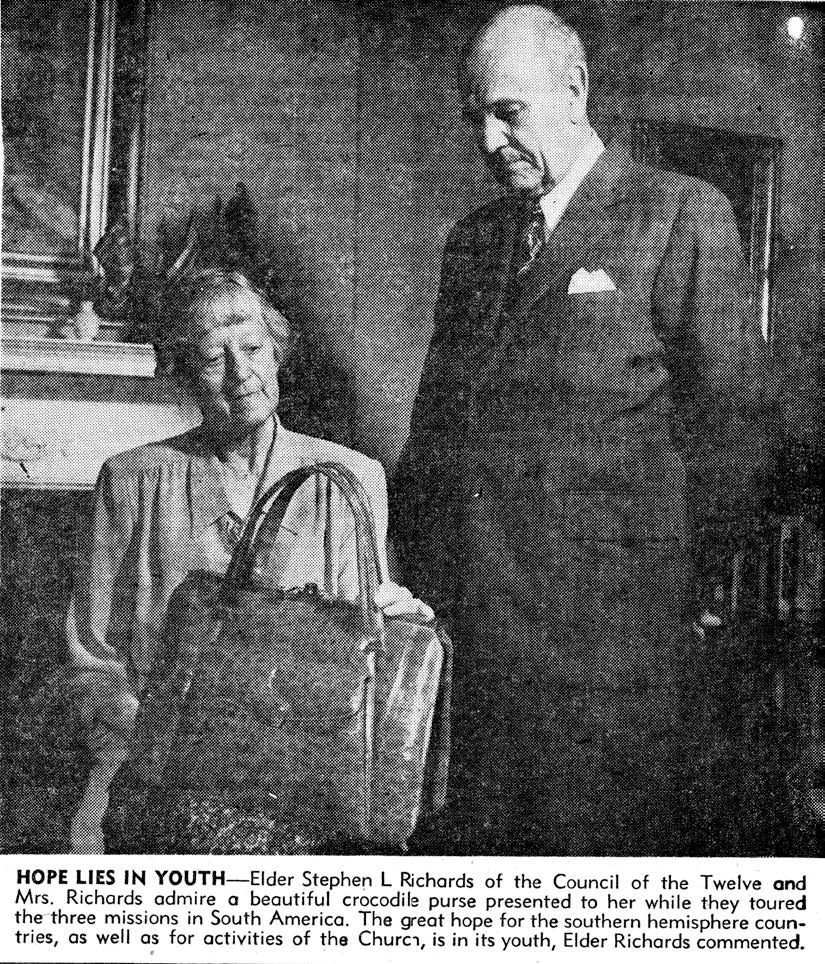 The Richardses admire a crocodile purse that was presented to them during their tour. Courtesy of CHL.
The Richardses admire a crocodile purse that was presented to them during their tour. Courtesy of CHL.
Feb. 15—I suppose this is the first time we haven’t sent valentines, and today I received Louise’s letter and a valentine from Irene Allen and Allie. I haven’t had any time to shop and they won’t let any article leave the country, so that saves a lot of time and money and when we get home things will be as ever, I hope. Everything seems to come from U.S. or England or France and only alligator bags are really Argentinian. There is no paper around and I haven’t seen or spent any money since I left Salt Lake. We have been in three different countries and they all have different money so we just let the mission presidents take care of us and pay them when we leave their countries. . . . Hope you don’t freeze to death this winter. We just can’t sense being cold. This last week has been really hot. We could close our eyes and imagine we were near Pocatello on the way to the Hebgen[60] in July. And here we are riding along in Argentina. Now the low hills are in view and tomorrow we will see some mountains. It’s the rule here to honk at every intersection. You can imagine the mad noise with the cobble streets added. Well, we are still well and I think Papa will last out. He is learning self control. He can’t just say do this and that as he is wont, for these people have their ideas also. It is surely interesting at least. Keep well, and excuse this paper and all.
Lovingly,
Mother.
Elder Howard J. Marsh, Argentine Mission Historical Report[61]
The morning was devoted to a missionary report and testimony meeting for the Elders of the Rosario District. 33 were present including 12 Elders from the district, Elder and Sister Richards, President and Sister Young, and the “Travelling Elders”. Started at 10:15 a.m., finished at 1:00 p.m. Elder Richards delivered a few words on developing our talents.
Elder Richards rested in the afternoon, and at night attended a special program in the central branch of Rosario (Given by the “Travelling Elders”—105 in attendance). He delivered a few words of greeting.
ROSÁRIO, ARGENTINA
Sunday, February 15, 1948
Daily Summary
Rosário District conference held at the Sorrento Branch
Elder Howard J. Marsh, Argentine Mission Historical Report[62]
In the morning was held the first session of the Rosario District Conference—at the Sorrento Branch.[63] 103 in attendance. Elders Brady, Young, and Richards occupied the majority of the time. The general theme was the magnitud of the work in spite of the humble surroundings. Elder Richards (assisted by President Young) blessed a young baby—giving it the name of Maria Julia. During the evening Priesthood and the Relief Society held their sessions, followed by the second general session. 110 in attendance. Speakers were Elder Lee Richards,[64] President Young, and Elder Stephen L. Richards. Theme the restored church of Christ.
CÓRDOBA, ARGENTINA
Monday, February 16, 1948
Daily Summary
Traveled to Córdoba and held branch and missionary meetings
Córdoba Branch Minutes[65]
Feb. 16, 1948—Monday
Special Meeting
Today at 4:30 PM., President & Mrs. Young together with Elder & Mrs. Stephen L. Richards of the Council of the Twelve Apostles. Accompanying them were Elders Howard Marsh & Lee Richards.
This morning, Elders Bowman & Hawkins arrived from Villa María for a special district meeting with Elder Richards.
At 8:30 this evening, we held a meeting in the Local to which all of our members able to come as well as the general public were invited. Elder Jesse N. Hawkins, Pres. Young, Sister Young, preceded Elder Richards who spoke on the “message of Mormonism,” while Pres Young translated. A very fine spirit prevailed, and the meeting was attended by approximately 60 people.
After the general meeting, a special district elders meeting was held. Each elder bore his testimony, as well as discussing the particular problems encountered by him, & suggestions for improvements in existing missionary aids, viz., literature, projectors, phonographs. Elder Richards concluded the meeting by giving us words of encouragement, beseeching us not to despair in the face of seeming defeat or difficulty; also stressed the missionaries should seek to be more dignified in bearing, speech, & relations with members & investigators.—Further questions were discussed & answered by Brother Richards & Pres. Young.
The party left Tues. morning for Rio Cuarto.—This is the second time in 22 years that a member of the Quorumn of the Twelve Apostles has visited Argentina!
s/
RÍO CUARTO, MENDOZA, AND BUENOS AIRES, ARGENTINA
Tuesday, February 17, to Thursday, February 19, 1948
Daily Summary
Traveled to Río Cuarto, Mendoza, and Buenos Aires and held branch and missionary meetings
W. Ernest Young, Argentine Mission President[66]
February 17 the party traveled to Rio Cuarto about 75 miles to the south of the city of Cordoba, where the first event was an elders’ meeting held for four elders in Rio Cuarto at the Hotel Roma in Apostle Richards’ room, and later in the evening a meeting was held at the branch[67] local with eighty-one persons attending.
W. Ernest Young, Argentine Mission President
February 18 the mission group drove west to Mendoza, at the foot of the Andes, and held an elders’ meeting with the four missionaries in that city. This was followed with a variety program and a branch conference at which twenty-nine were in attendance. At the Grand Hotel there was some difficulty to find suitable rooms; also Elder and Sister Richards had intended returning to Buenos Aires on the train as a special experience on the English Railway, but the schedule of trains was too delayed for them.
Elder Howard J. Marsh, Argentine Mission Historical Report[68]
Feb. 19, 1948. Travelled the 1100 kilometers[69] to Buenos Aires, arriving late at night. No stop-overs en route.
BUENOS AIRES, ARGENTINA
Friday, February 20, 1948
Daily Summary
Business visits and dinner at home of L. Pierce Brady
W. Ernest Young, Argentine Mission President[70]
February 20 I accompanied Elder Richards to the downtown business center of Buenos Aires, and inspected the money exchange houses for Traveler’s and other checks, and the exchanges of the banks, etc. Also Elder Richards ordered a tailormade suit at the James Dry Goods Co. Mr. James, an Englishman, was sociable and told us about his cattle ranch and winning prizes at the fairs for his good breed of cattle, saying, “Yes, I make a damn good living.” In the evening Elder and Sister Richards were entertained and dined at the home of the mission’s first counselor, L. Pierce Brady and wife. Brother Brady is in the brokerage import business.
LA PLATA, ARGENTINA
Saturday, February 21, 1948
Daily Summary
Relief Society bazaar and surprise party in La Plata for the Richardses’ wedding anniversary
W. Ernest Young, Argentine Mission President[71]
February 21 the group traveled to La Plata,[72] where they attended a Relief Society bazaar. Special honors were extended to Elder and Sister Richards in commemoration of their forty-eighth wedding anniversary, with an attendance of 105 people.
LA PLATA, ARGENTINA
Sunday, February 22, 1948
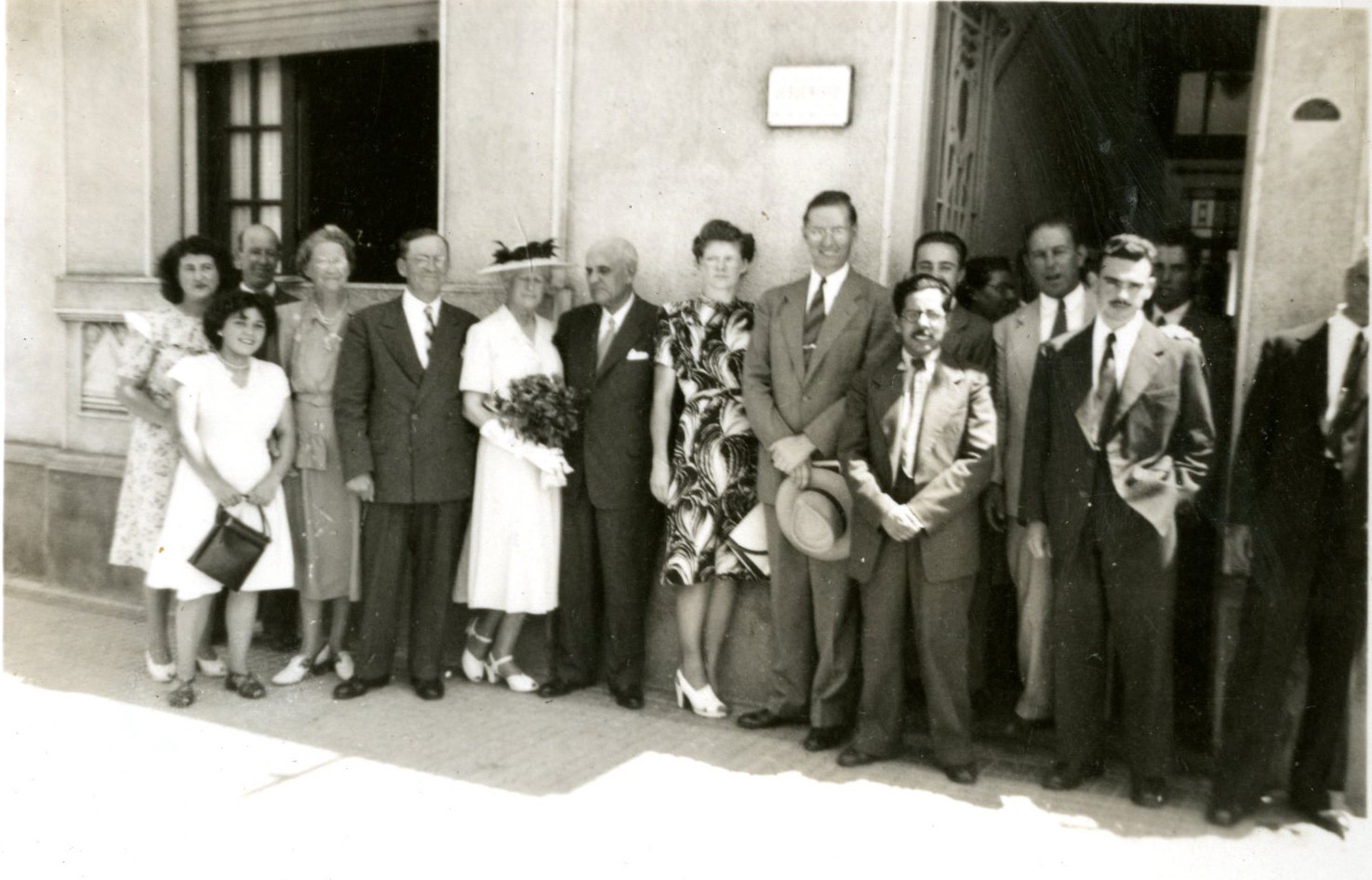 The Richardses with some members of the La Plata Branch. Courtesy of CHL.
The Richardses with some members of the La Plata Branch. Courtesy of CHL.
Daily Summary
Conference in La Plata and Irene’s contemplations in Buenos Aires on mission tour so far
News Article: El Dia[73]
The Mormon Church Will Speak Today in the La Plata Mission
Mormonism, represented in all the world by the Church of Jesus Christ of Latter-day Saints, which has been functioning since 118 years ago, having commenced its activities in the United States under the inspiration of its founder Joseph Smith. The principles of the said religion are based on the revelations made by a celestial spirit named Moroni, who was in his material existence the son of Mormon, the last prophet of the ancient Americans, descendant, and the same time from the pre-Flood[74] prophet Jared.
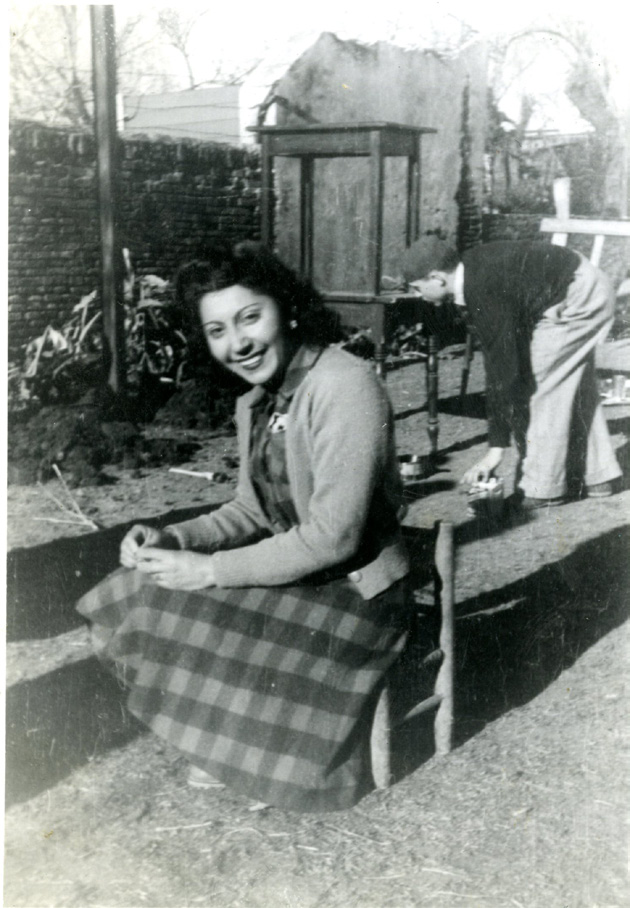 Elder Richards gave a priesthood
Elder Richards gave a priesthood
blessing to Dora Lencina when she was ill. Courtesy of CHL.
The Mormons believe in God, in Jesus Christ, and in the Holy Ghost; contrary to other religions, they consider that men will be punished for their own sins and not for Adam’s transgression; they admit the precepts of the Bible as fundamental, besides the teachings of the Book of Mormon or Book of Gold: their organization has been based on the primitive Christian church and its integrants do not receive pay. Mormonism abandoned in a definite manner polygamy many years ago; it had characterized them since their beginning, having adapted themselves to the exigencies of the modern life.
A chief of the said sect, Mr. Stephen L. Richards, who is visiting our country, proceeding from the United States and has just realized an interesting tour of all of the principal Argentine cities, will preach today, at 10 o’clock, in the temple that the aforementioned cult has established at 1169 63rd St. Mr. Richards will arrive accompanied by the president of the mission in Buenos Aires, Mr. W. Ernest Young, and will be received by the integrants of the local branch, Mss’rs. Gorton, Ogden, Bruce, and Marsh.
Elder Howard J. Marsh, Argentine Mission Historical Report[75]
Feb. 22, 1948. Conference at La Plata. Remarks by Elders Pierce Brady, H.J. Marsh, President Young, and Elder Stephen L. Richards. 81 in attendance. Elder Richards’ theme—“The dignity of man.”
Dined at noon in the home of the Salvioli family. Visited a sick member, Dora Lencina, and returned to the Capital in the afternoon.
Elder H. Clay Gorton Missionary Journal[76]
Sunday Pres. Young & Bro. Brady came for Priesthood Meeting & at 10:00 we held a Special Conference for Apostle Richards. . . .
There are certain conditions existing in the Branch on which a certain amount of advice is necessary. If Apostle Richards had known all these conditions he could not have spoken better or more to the Subject.[77] or written policy for [the] District.
Irene M. Richards Letter[78]
Buenos Aires
Feb. 22, 1948
Dear Lynn:[79]
We have been traveling for nearly two weeks south to Rosario and west to Mendosa and are now back in B.A. It’s good to return to the mission home after trying anything once. We enjoyed the auto, although it has been hot and not very good roads. There are always some parks, hotels, shops which are special about each town and we have been staying in the Palace, the Plaza and all the best hotels, which are old and “passe”. When we finally got one with good plumbing, there was no water for it. So I enjoy the old Spanish romance of the beauty of the past and Papa endures the accommodations and hopes for the better one next place. The best is none too good. Oh, how this country needs a little freedom. There is such a richness to the soil and so much of it, that democracy would make it grow fast.
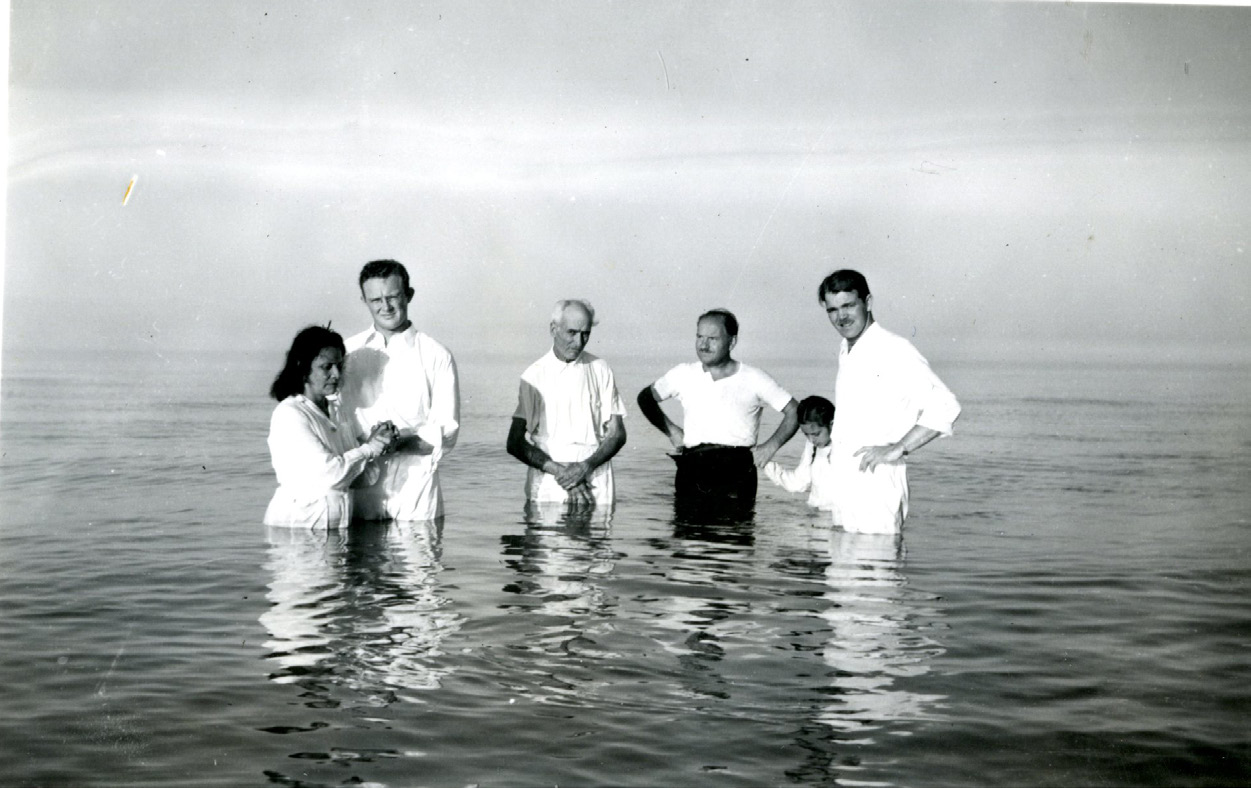 Baptisms in La Plata, Argentina, on March 22, 1947. Courtesy of CHL.
Baptisms in La Plata, Argentina, on March 22, 1947. Courtesy of CHL.
We nearly met “Peron”.[80] He ran across us on a street. All of a sudden the sirens blew and all policemen ordered our car to the side; and apast us whizzed about a dozen cars. He was coming home to his palace on the River after his official day in the “Pink House”. I guess Pink is to distinguish it from our “White House” in U.S. and it is tinted pink.
Now, we have met all of the missionaries in Argentina. They are all fine and enthusiastic and efficient and rather an unusual number of them talented in music. This helps most in the concerts they give, whereby they meet the more cultured citizens. If they just tract, the contacts are very lowly and unintelligent. So many are uneducated, and it is to the youth we must look for future members. They have no religion, ordinarily, and are hoping for freedom in education. Some don’t even know what the Bible is. The Mutual and Primary seem to do a fine work for after 10 years the children remember some good things and are attracted to the missionaries when they meet them. By one means and another, they are hopeful and energetic in their jobs, preaching, teaching Eng. [English] classes, singing, playing basket ball, cottage meetings, etc.
 Baptismal service in La Plata, Argentina, on March 22, 1947.
Baptismal service in La Plata, Argentina, on March 22, 1947.
Courtesy of CHL.
At every “locale”[81] (which means branch) the saints have given us a great welcome. They have put on programs and dances, in Spanish, so we really don’t know what has been said about us. I can recognize some words and know when they are addressing us by their expressions and motions. It’s quite disconcerting, and (tiresome) to sit at attention, and try to look intelligent. Papa always speaks for me, and does a very good job. They have showered us with flowers, cakes, sweaters, doilies, handkerchiefs, scarfs, and even a toothpick holder. They have the deplorable habit here of picking teeth, but maybe that is not the worst thing. The saints and all are killing us with kindness. We will have finished with Argentina by Friday, when we take the boat for Uruguay. Papa has some special work here with the branch and mission home for two or three days to finish up. That gives me an opportunity to wash my hair and clean up in general. What is the advice in the Testament, “When you leave a city shake the dust off your feet”?
Well, we are not going to Chile. It’s too high for Papa, and there is plenty to do here. . . .
 The Youngs and the Richardses in front of the monument “Hill of Glory” in Mendoza, a tribute to the army of the Andes. Courtesy of CHL.
The Youngs and the Richardses in front of the monument “Hill of Glory” in Mendoza, a tribute to the army of the Andes. Courtesy of CHL.
After a very long drive on our way home, Papa was somewhat tired, but by resting a day he recovered. The weather is very hot and we are not accustomed to it. The nights are cool and the people don’t go to bed until after midnight, so by morning it is more pleasant. As soon as the evening comes, everyone seems to be either sitting in doorways, or on sidewalks, or walking in parks and on beaches. They rest in their dark houses during the heat. I guess they know what they are doing when they take a “siesta” thru the heat of the day, but we kept on traveling, which was a mistake. There are no screens or windows or doors and in order to keep insects out and their houses cool, places are kept dark. Maybe that’s why so many have poor eyesight?
At “La Platte”[82] we saw the museum where is displayed many prehistoric monsters. We also saw a Cathedral of great beauty inside.
At Mendosa we were near the Chilean border. The Andes were wonderful, with snow. They seemed rugged and about as our Rockies look. The soil is red like Bryce and the streams are red, although there have been no storms lately.
Papa is fine again and I am also. Lois’s letter took one month to come. Louise’s and Allie’s, air mail, five days. Thanks for all correspondence. We know you are well thereby. Maybe there will be further word from home in Uruguay.
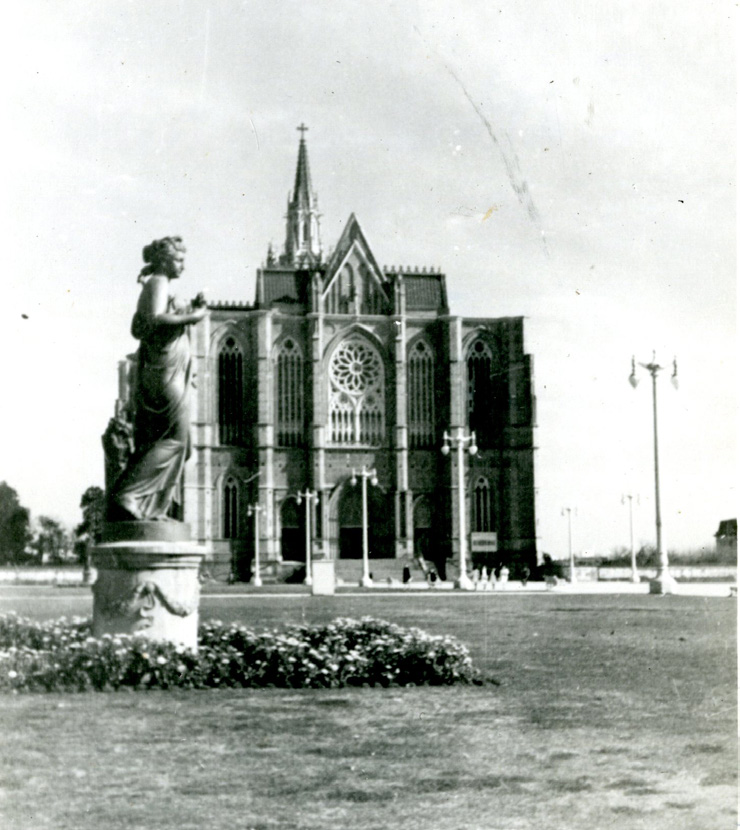 Catholic cathedral in La Plata visited by the Richardses. Courtesy of CHL.
Catholic cathedral in La Plata visited by the Richardses. Courtesy of CHL.
Lovingly,
Mother.
BUENOS AIRES, ARGENTINA
Monday, February 23, 1948
Daily Summary
Meeting with Argentine Mission presidency and letter to the First Presidency
Elder Howard J. Marsh, Argentine Mission Historical Report[83]
Feb. 23, 1948. Elder Richards and President Young spent the morning in consultation with Elder L. Pierce Brady, and the afternoon in consultation with the newly formed presidency of the mission[84]—President Young, Elder Brady, and Elder E. Stott. Remained overnight in the home of Elder Brady.
W. Ernest Young Letter[85]
Mr. Henry A. Smith,
Editor, Church News Section,
The Deseret news Publishing Company,
Salt Lake City, Utah.
Dear Brother Smith:
Thank you for your letter advising of the new “mission section: of the Church News Section of the Deseret News. We are sure that news from the missions will be of great interest not only to ex-missionaries, but also to all readers of the News. We are happy to hear of the development of this important section.
Following is a brief biographical sketch of the members of the new presidency of this mission. Please feel free to alter it as you see fit.
“During the visit of Elder Stephen L. Richards, the organization of the Presidency of the Argentine Mission was completed.
“President W. Ernest Young has been presiding over this mission since September, 1944. He is a veteran missionary, having served in the Mexican Mission from 1910 to 1913. After serving as Bishop of the Juarez Ward, Juarez Stake from 1922 to 1933 and a teacher in the Juarez Stake Academy from 1919, President Young attended the Brigham Young University from 1933 to 1935 when he received a degree in Education. He was then called to serve as President of the Argentine Mission from 1935 to 1938 after which he returned to his teaching post in Juarez until called upon his present mission. Many years of experience and faithful service in various callings in the Church and his excellent knowledge of Latin American culture and customs especially qualify him for the responsibility he now holds. He is accompanied and efficiently aided by Mrs. Young.
“President L. Peirce Brady was set apart as First Counselor in the mission presidency in October, 1947 by President George F. Richards in Salt Lake City. Elder Brady was a missionary in the Argentine Mission from 1936 to 1939. He is a graduate of the Georgetown University, Washington, D.C., having studied Economics and International Trade. He served for several years as economic adviser in the American Embassy in Brazil and is at present Managing Director of the Iromac Commerical Corporation and Vice President of the Pan America Trade Development Corporation. He is residing with his wife and two daughters in Buenos Aires.
President E. Keith Stott was set apart as Second Counselor in February, 1948 by Elder Stephen L. Richards in Buenos Aires. Elder Stott studied Business Administration two years at Brigham Young University and one year at George Washington University before being called to Army service from 1942 to 1946. During this period he served as an Administrative Assistant in the Office of the Chief of Staff in the War Department and accompanied General George C. Marshall on trips abroad upon several occasions as personal secretary. He received the Legion of Merit for his Army services. He was called on a mission from the Arlington Ward, Arlington, Virginia in January, 1946 and was joined by Mrs. Stott and son in March 1947.”
Enclosed is a photograph of the Argentine Mission Presidency.
We will try to comply with your request for mission news and hope to be able to forward to you from time to time items of interest.
Please accept our best wishes for continued success.
Very sincerely, your brethren
Argentine Mission Presidency,
by _______________________
W. Ernest Young, President.
Encl. photo
Stephen L Richards Letter[86]
February 23, 1948
The First Presidency
47 E. South Temple St.
Salt Lake City, Utah
Dear Brother:
We were happy to receive your letter of February 13th after you had received our cable. We have just finished a long and rather strenuous journey through the branches of the mission. We shall not attempt at this time to describe our experiences or the conditions we found. Suffice it to say that we believe the work is progressing in spite of handicaps.
We found all missionaries, with two or three exceptions, to be in good health, and steps are being taken to improve the conditions of those who are not well. We have extended your love and blessings to all the Saints and your greetings to many friends. Our reception has been most cordial wherever we have been. Our speaking through an interpreter, of course, has not been too satisfactory, but we have done what we could to help convey the message of the Church to those who have listened to us. We shall have much of a detailed nature to report to you on return.
During a part of the time we were away, Brother Brady, Chief Counselor in the Mission Presidency, has endeavored to make a study of housing, and the next few days here will be given over in a large measure to the continuation of that study. Nothing very concrete has yet developed.
You were kind enough in your letter to sound a caution about health. I am pleased to report that I have been th[r]ough the ordeal of travel and meetings and come out in pretty good shape. We think that the most strenuous time is over now. With the exception of a slight illness, Irene went through exceptionally well.
Our reservations are now almost complete for the following schedule: We leave Buenos Aires on February 27th for Montevideo. We leave Montevideo for the Brazilian mission on the Moore-McCormack boat, SS URUGUAY, March the 5th. We arrive at Santos, Brazil, March 8th and spend until March the 22nd in the Brazilian mission. On March 22nd, we sail on the SS ARGENTINA for New York, reaching there April the 5th. Unfortunately, this schedule will not get us home in time for Conference, but it is the best we can do on the transportation available to us. We have felt to follow the doctor’s advice and not fly. We made arrangements so that we could have gone from Mendoza in the western part of Argentina to Santiago, Chile, but discovered that by railroad or auto, we would have to ascend elevations above 12,000 feet or fly up to 22,000 feet without pressurized cabin planes, so we decided it would be unwise to undertake the trip. We do have, however, reports from a number of men whom we have met who have had experience in Chile.
We hope this will find you all in good health. With our kindest regards to yourselves and the brethren, we are
Affectionately yours,
[Stephen L Richards]
BUENOS AIRES, ARGENTINA
Tuesday, February 24, 1948
Daily Summary
Irene reflects on events in Buenos Aires and Elder Richards prepares final instructions
Irene M. Richards Letter[87]
Buenos Aires, Argentina
Feb. 24, 1948
Dear Georgia:[88]
Since we received your letter here we have traveled over Argentina to Rosaria in the south, where the roads ended up in dirt, and to Mendosa, to the west, where we saw the Andes. . . .
At every city is a Palace, or Plaza Hotel. We have had the best and they are beautiful in Spanish style, but not American by any means. We are doing fine though and hope to live until spring. We can’t realize that it is cold at Toledo, when we are melting and eating fruit and seeing flowers in profusion. The moon even seems different. We really see it on another side, don’t we? There is no dipper, we see instead the southern cross. The sky and stars are very wonderful and clear.
There are no screens on houses and they must keep shutters closed to keep out insects and heat. So houses are dark but cool, and the mosquitoes do their dirty work at night. You wouldn’t know your own mother now, but no one else knows how she should look so it doesn’t seem so bad. This hired girl at the mission says she thinks Mrs. Richards is the sweetest person she has met; no doubt the mosquitoes thought the same thing last night. So I am doing O.K. It got around the mission that it was our 48th and we have received flowers and cakes, and a sweater hdkf [handkerchief], and scarf, and at least 6 telegrams. These people are killing us with kindness. . . . We met some college students from Peru who are sons of rich land owners, studying at La Platta University.[89] One of our missionary boys from San Leandro[90] is teaching them English. They were very interested in U.S. and knew something of some Californian names of cities, but they were eating up the Book of Mormon. Our boys make many friends at the universities with their chorus and basket ball team. The young people are the ones most interested in our church. The 3rd largest cathedral[91] in the world is here, a very magnificent interior, tall white marble pillars, gothic ceiling and marble floors (polished like glass) and stained glass windows. We also saw the museum of prehistoric animals. I think Noah was unable to get them into the ark, they were so huge and fierce, that’s why they are extinct now. Papa says he’s not worrying about that phase of creation, but it’s wonderfully interesting.
Next week we start touring Uruguay. . . .
We hope you are well, and we thank you for your letters. . . .
Lovingly,
Mother.
W. Ernest Young, Argentine Mission President[92]
Final Instructions of Apostle Richards
February 24, 25, and 26 Elder Stephen L. Richards spent most of the time on these dates at the mission home making his summary of his visit to the mission. He prepared his recommendations and counsel for the mission, offering suggestions that would help the proselyting work, also concerning costs of rentals, and the part to be paid by the elders.
BUENOS AIRES, ARGENTINA
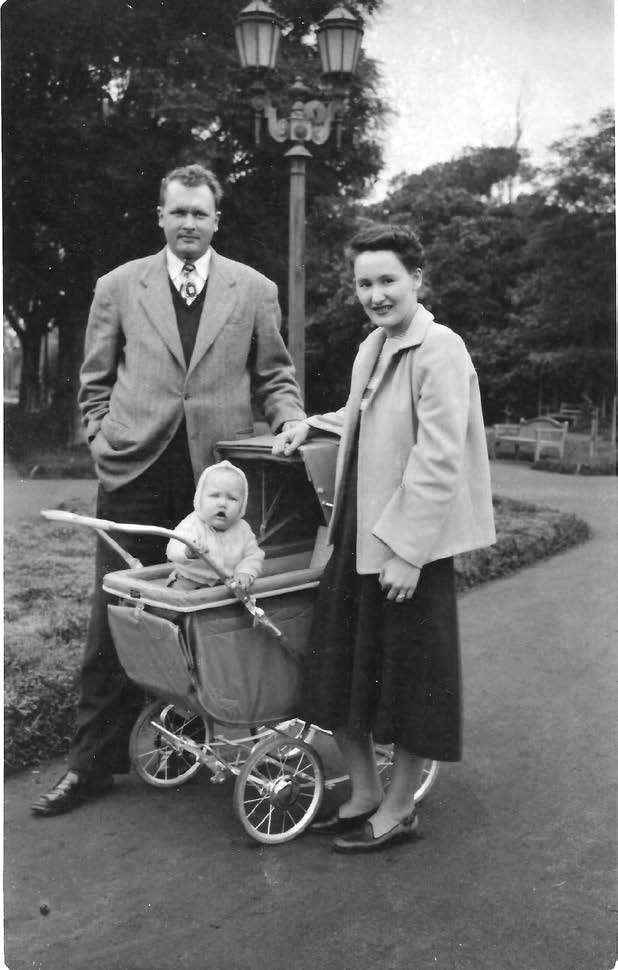 Baby Diana with her parents, Dale M. and Jean Christensen, in Palermo Park. Courtesy of Diana Christensen.
Baby Diana with her parents, Dale M. and Jean Christensen, in Palermo Park. Courtesy of Diana Christensen.
Thursday, February 26, 1948
Daily Summary
Reviewed reports and attended baby blessing
Elder Howard J. Marsh, Argentine Mission Historical Report[93]
Feb. 26, 1948. Spent the morning reviewing missionary reports. Lunched at the home of Pedro Sanchez (member from the Rama of Liniers). Spent the afternoon and evening in reviewing the mission situation with President Young. At night, as invited guests of President Young, dined with Brother and Sister Dale Christensen. Brother Christensen is a former Argentine missionary now connected with the embassy. A father’s blessing was given to their baby, who was given the name of Diana Maria Christensen. Elder Stephen L. Richards acted as mouthpiece. He was joined in the circle by the father, President W. Ernest Young, and Elder J. S. Brammer.
BUENOS AIRES, ARGENTINA
Friday, February 27, 1948
Daily Summary
Meeting with Argentine and Uruguayan Mission presidents, departure by ship to Uruguay, observations of and recommendations for the mission, summary of Argentine tour, and letter from Elder Richards to the Argentine Saints
W. Ernest Young, Argentine Mission President[94]
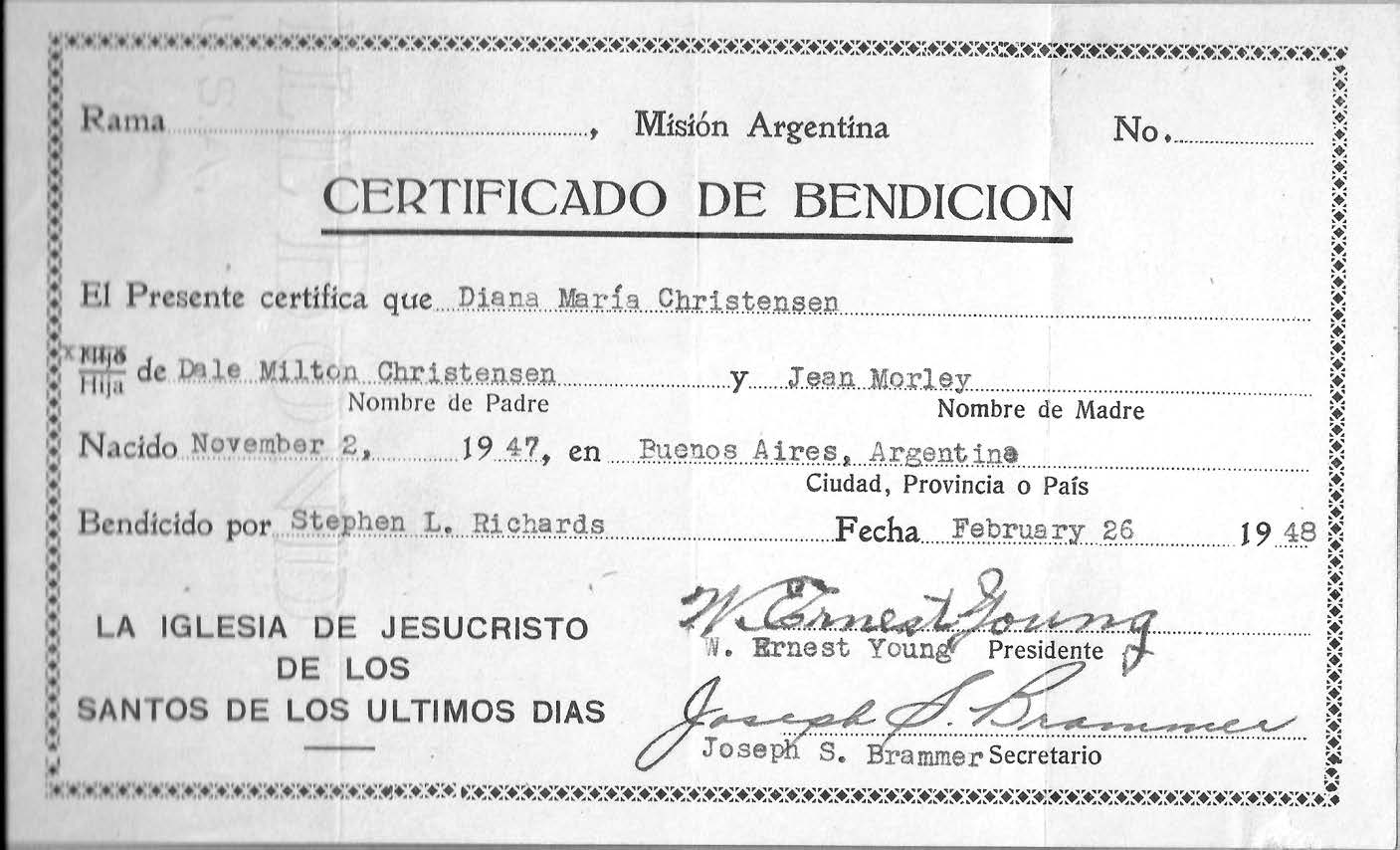 Blessing certificate of Diana Christensen. Courtesy of Diana Christensen.
Blessing certificate of Diana Christensen. Courtesy of Diana Christensen.
February 27 a mission presidency’s meeting was held at the mission home, with President Frederick S. Williams attending from Uruguay. Elder Richards conducted, and gave his final impressions and instructions for the two missions regarding the possible cooperation with literature and other Church facilities. In the evening Apostle and Sister Richards left on the riverboat for Montevideo, Uruguay. This is the first time that I had seen one of the General Authorities in the mission in my ten years in three foreign missions. Times have changed with faster and better travel and communications. This has been a great privilege to travel with an apostle and listen to his inspirational counsel.
Irene M. Richards Journal[95]
Bro. Brady [first counselor in the mission presidency] made a talk at the farewell meeting for us at Buenos Aires. He said “He had been in consultation with Government Officials in the U.S. and also with big business men of the countries, and after sitting in session with Bro Richards for several hours, talking about mission affairs, he had concluded that he had never met a man with such clear, good judgment and reasoning, and directive power as Bro Richards. He said if these said executives could have the acumen that Bro Richards had, what a great good could be accomplished.” And Brady is the head of a few million dollar corporation. maybe he knows.
Mission Presidency Meeting[96]
Extracts of discussion held in Mission Presidency Meeting in Buenos Aires, 27 Feb 1948 directed by Elder Stephen L. Richards and attended by President W. Ernest Young with his two councilors (1) Elder Peirce L. Brady and (2) E. Keith Stott, and by President Frederick S. Williams.
Locales
Brother Richards said that the system of locales used in the Argentine and Uruguayan missions was something new to him in missionary work; that they have apparently served a good purpose in times past and perhaps are the best available means at present. There are 23 locales in Argentina at present for which rent is paid. Query: Is the locale system better for the missionaries than “pensiones” (boarding houses)?
Bro. Williams said that a better method would be to build chapels with missionary quarters which is, of course, out of the question at present. Further stated that the system of pensiones was employed at one time with very poor results. At no time was the system successful. The food was different from that <to> which the elders were accustomed and was very bad. The natives prepare very greasy food including much pastry, etc. Very little advancement was made in missionary work under this system; missionaries had no place to which they could invite investigators for meetings. It is better to rent a place and invite friends to it. It is true that “friends” were made in the pensiones, but no members. Bro. Williams mentioned the case of some ex-Brazilian missionaries who were in their mission many months without the opportunity of offering a prayer in public or holding meetings, blessing sacrament, etc. for lack of a place in which to meet. There are at present seven (7) locales in Uruguay which are generally better than those in the Argentine Mission; a higher rental is paid, the average being around $55.00 per month. They were fortunate in renting new homes just about in the locations desired.
Bro. Richards pointed out several differences in the situation in the U.S.: Halls can there be rented or borrowed; schools can be utilized to hold meetings in, etc. Good boarding houses are available to the missionaries. He observed that locale rentals in the Argentine Mission are rather modest, the highest being at present $62.50 per month and the lowest around $16.00. Query: Could we hope to get better places by paying more rental? Could we consistently ask the missionaries to increase their contribution to the payment of rent?
Bro. Young stressed the difficulty in finding locales to rent; owners would rather sell at present than rent. Even after months of trying—using banks, newspaper adds and walking the streets—we have not been successful in obtaining locales to meet our needs.
Bro. Richards felt that asking higher rent from the elders would be justified. Although he had <heard> that missionaries could possibly get board and room here for about $25.00 a month, this policy is not acceptable. Inadequacy of the board in the pensiones was stressed by all present as being detrimental to the health of the elders over a period of time. The average contribution of missionaries per month toward paying rent of locales is $3.75 per individual. Missionaries in Uruguay are paying $5.50 each (in better locales).
Missionaries spend on an average of about $21.00 for food and room under the locale system although their total expenses run to an average of $50-52 per month. Some investment items, however, are included in this figure in cases, such as clothing, bicycles, etc. Food is generally much cheaper here than in U.S. Milk, 8 cents a litre; bread, 10 cents a heavy loaf; meat, 20 cents a pound for choice cuts; eggs, 45 cents a dozen (which is temporarily high price). Fresh vegetables cost about the same or in some items a little more than in the U.S. Canned foods used very little; prices exorbitant.
Bro. Richards pointed out that the Church makes an investment of about $1,000 in each missionary in the mission (transportation, etc.). Perhaps they should not get preference in expenses. Average rental of $3.75 does not seem quite fair in the Church and is below average in other missions. Seventy-nine (79) missionaries in the mission are paying a total of about $288.00 of a total rent paid of $646.00—about 45%. If increased to $5.00, the total paid by the missionaries would be $395.00, or about 60% of total rental. The Church is now paying as its share of the rental about $15.00 per month per local (average). This would not seem high at first glance, but upon considering the membership, it is a rather high per-capita rental.
Unanimously agreed that the regular weekly reporting system would be put into practice at once.
Study
Bro. Richards emphasized that missionaries should not get into debates among themselves. Established principles and methods of approach, etc., should be stressed in study. Study must be supervised. Tracting methods should be studied and the “know-how” acquired by missionaries.
Reports should be studied carefully to determine, for example, if a missionary is spending too much time visiting saints and too little tracting and other proselyting.
Mission president should teach elders how to hold cottage meetings. Steps toward acquiring meetings might be: (1) get into the home; (2) use available slides, etc. (3) have prayer and songs; and (4) introduce lessons on the Gospel.
Games and Musicales
Pres. Young said that the group of “Traveling Elders” (including 12 men composing a chorus and basketball team) had trained to render this service for a period of about two months. It is felt that they have made a great contribution in introducing the Church. The efforts of former organizations of this nature have attracted people to the Church who later became good members. Tracting and preaching when possible are included in the activities of the group.
Bro. Richards remarked that the great spiritual message should be kept foremost in the minds of the elders devoted to this work and every effort made to capitalize on their efforts. Work should be well supervised. When a missionary goes home, he should feel he has been on a mission and delivered his message.
Club
Bro. Richards opined that, since recreation has an important place in our program, the club could stand improvement and made more attractive.
Recreation Hall
Agreed by all that a recreation hall would be a very desirable thing. It should be built in such a location that it could be put to good use among the branches. In any building program, it would be among the first items. Would not have to be of expensive construction. It was felt that a basketball court should be included. Tile or cement floor could be used and would be cheaper than wood in this country. A plain finish would be adequate for recreation and for district and bi-annual mission conferences. A tentative project for the presidency of the mission would be to look for a lot and secure an estimate of costs of construction of a recreation hall.
Mission Home
Bro. Richards favors the Belgrano section of Buenos Aires because it is more accessible to the center of town, where many transactions of the office force take place; it gives better impression as it is in a far better section of town than Liniers; it offers good school facilities to children of mission presidents. There are many large homes in the area, one of which could probably be purchased much more cheaply than a comparable building could be erected. Recommended that the mission presidency be authorized to make a search with a view to obtaining a suitable mission home in Belgrano. Sustained by all present.
Chapels
It was agreed that the following steps be taken: (1) improve locales to the extent feasible; (2) as soon as possible get land and an estimate of costs and build a suitable hall for recreation and to take care of conferences; (3) find and buy a suitable mission home when the opportunity presents itself.
The present church-owned club could be sold to apply on the recreation hall. Space could possibly be acquired to include later on an adjoining chapel. Bro. Richards ventured a rough estimate that a hall would probably not cost less than 35–40 thousand dollars. The site of present club not considered appropriate.
The building of one or more chapels would depend on the progress of the work after the above projects have been completed. When the need develops, it would be a desirable thing to have a chapel in Buenos Aires. It would seem better in the beginning to have one big, creditable chapel (80–100 thousand dollars) than to build first small chapels in the area. Chapels in the interior cities must depend on needs.
Branch Administration
Brother Richards suggested working toward local (native) administration as soon as possible. Clear the missionaries for proselyting work. The matter was left for study, having in mind (1) opening the way for more service outside the branch organization by missionaries (2) developing individual responsibility of branch members.
Hospital and Clinic Service
Mission has been donating 500 pesos per year to the British Hospital and receiving free medical attention for the missionaries. Services received to date far exceed this nominal amount. We should have an understanding with the officials of the hospital as to the adequacy of our donation in view of increased number of missionaries. Bro. Richards felt it would be advisable to give all missionaries an examination each year to insure their health.
Literature
Bro. Richards remarked that these missions should share in the new, attractive literature which the Church is putting out. U.S. tracts could be copied or adapted and printed in the mission. Is convinced that more books should be obtained. Spanish translation work is going forward. Bro. [Eduardo] Balderas needs a larger staff. Bro. Gordon Hinkley manager of the Church Literature Committee, will push the work.
Bro. Richards will recommend that the book by Bro. Hinkley (“What of the Mormons”) be printed in Spanish. It would seem that the people need a non-controversial history of the church. Bro. Richards will suggest: (1) that steps be taken to get out immediately the translations already prepared; (2) that Bro. Balderas be provided with additional help; (3) that lessons be provided promptly; (4) that a search be made for materials to be adapted to our needs.
Argentine saints available to aid in translations are: Sister Euridece Turano, now attending the “Y”; Brother Fermín C. Barjollo, Córdoba, Argentina; and Sister Amalia Taffuri, who intends to leave Argentina for Provo in April, 1948 to attend the “Y” this fall.
Missionary Training
Missionaries are here kept in the office three or four days upon arrival for orientation purposes, taking care of documents in Embassy, etc. Short classes and discussions give the president an opportunity to observe and properly assign missionaries.
Special language training in U.S. of missionaries for 3 months before departure would not seem advisable. Practical training in the mission seems to get the best results in the given time.
Government Relations
The Catholic clergy, which has a strong influence in immigration policy of the government, would oppose us as much as possible in anything we tried. It is felt advisable by all to avoid the raising of questions with the Argentine government. Missionaries should not be sent to the mission in groups of more than 5 or 6 in order not to alarm the clergy. It was suggested that we get names of missionaries from Salt Lake in sufficient time and procure landing permits as prescribed by the law of the country. The word “missionary” should not be used in application for passports in the U.S. “Representative” should be substituted. We should, of course, aim to make as many influential business friends as possible.
Communications with Headquarters
Any light mail of importance should be sent by air. Equipment such as projectors, etc., could be brought into the country through the missionaries as part of their standard equipment. Films might possibly be sent by air if necessary without import difficulties, but best to send by missionaries.
Budget
Bro. Richards suggested making an amended budget in view of organization of the mission presidency and other items recommended, including improving locales, higher rents, purchasing of bedding, etc.
Packages from Home
Parents should not send packages to missionaries because of the money and time needed in getting them out of the “aduana” (customs). In some instances the duty exceeds the value of the gifts. Perhaps the “Church News” could be utilized in securing the cooperation of relatives and friends. Missionaries should advise their own people.
Office Organization
Bro. Richards believes that the missionary staff in the office can be readily persuaded that efficient business methods are as helpful to them as to everyone else and to comply with a schedule and organization that is exacting. A well-defined plan is necessary. The matter should be studied thoroughly. Charts depicting positions and line of authority is always helpful. When each one knows his duty, all enjoy their work more. Although the conveniences are bad in present home, they need not stand in the way of a well-defined organization. Get into a routine, allowing for exceptions.
Mission Presidency
Suggested that Bro. Stott study offices activities, diagram the situation, and make recommendations to the presidency with the opportunity of carrying them out if approved. Bro. Brady could do the same in branch organization. Proper care of the missionaries is dependent to a very large degree upon the office organization. Time spent in the various activities of the office staff could well be studied with a view to greater efficiency.
Bro. Richards suggested that the doors of the office be kept locked and that no one enter unnecessarily. People could knock and call the person with whom they wish to speak into the hall to converse; entire office force should not be disturbed by the conversation of two individuals. Missionaries should not come to the office for mail. Those in the district should have little more reason to come to headquarters than those in the interior. It involves much wasted time.
Mate[97]
Bro. Brady will send samples of mate by mail to Bro. Richard’s office. A competent, impartial analysis will be made before final decision is handed down on the harmfulness of the drink. Mate is not a problem in the Uruguayan Mission.
Mission Magazine (“El Mensajero”)[98]
Serves the two missions.[99] Provides translated articles and talks by the general authorities from the Era, Church News, Relief Society Magazine, The Instructor, church books and other literature otherwise not available to this people. Includes local news for both missions and articles and editorials by both presidents.
Bro. Richards requested that when a study has been made of office organization, the magazine for the two missions, etc. a report be sent directly to him giving an outline of organization, assignments, etc.
Return Travel
Some missionaries want to go home by round-about routes. It is felt that permission of parents should be secured and that parents be advised that additional costs and risks are involved if such is the case.
At present there are only two passenger agencies to the States: Moore-McCormack to New York (1st class about $600 and 2nd about $425) and Delta to New Orleans (only one class, about $600). Passage by cargo boat is from $375 up to $500.
Visiting Missions
Visiting between missions on semi-annual conferences is objectionable. Mission presidents should not leave missions. If an exception is made, the First Presidency should be consulted.
Conferences
Conferences of church held in Buenos Aires twice a year. All missionaries have been attending. These conferences give the members a chance to visit and gives them and friends some concept of the magnitude of the organization and work. Five to six hundred people attend the variety programs, and the Liniers chapel is overflowing during the three religious sessions on Sunday. Meetings of mission auxiliaries held on Saturday. Youth convention held in conjunction with one conference and the Gold and Green Ball in connection with the other offer young people the opportunity to mix.
Bro. Richards does not intend to represent these people as having all the characteristics of an honest people with the integrity necessary for a great advancement in the work of the gospel. Expenditure of missionary efforts and funds should proceed with precaution. He is not favorable to going all-out in making big investments unless more advancement is made than demonstrated up to now.
Dear Elder Richards:
I have included in these notes some detail which may be of no value, with a view to reminding you in a small degree of the trend of discussion.
Let me again express my keen appreciation for your visit and your helpful guidance.
Very sincerely,
/
E. Keith Stott
Elder Howard J. Marsh, Argentine Mission Historical Report[100]
Feb. 27, 1948. President and Sister F[rederick] Williams of the Uruguayan Mission arrived in the morning. The day was spent in consultation with the Presidency of the Argentine Mission and President Williams. At night a farewell party was held in the Liniers chapel. (6 p.m. to 7 p.m.). 120 were present. Departed from Argentina on the river-boat bound for Montivideo, Uruguay, in the company of President and Sister Williams, at 10 p.m.
BON VOYAGE/
s/
News Article: Church News[101]
An Apostle Tours Argentina
By Elder H. J. Marsh
(Special To The Church News)
Buenos Aires, Argentina—Millions of Argentinians were informed of the visit here during the past month of Elder Stephen L Richards of the Council of the Twelve through the great newspapers of this country.
But to the people of the interior among whom are many of the members of the Church in this land the visit of the Apostle was heralded by the sight of a blue Ford car bouncing along back-woods roads still bearing the license plates which proclaim Utah as “This is the Place.”
The meaning of this phrase was explained to the delight of the crowds, large or small, which gathered around the car at each country stop. . . .
Traveling exclusively by automobile, Elder Richards completed a 2,600 mile trip that took him to every district of the Argentine Mission. This extensive tour gave every member and every missionary in this vast country an opportunity to meet the Church leader. For most all of the members it was a first chance to see and talk with one of the general authorities of the Church. This is the first South American visit of a general authority since Elder Melvin J. Ballard created the mission in 1925.
The tour of Argentina began officially with a report and testimony meeting of the missionaries of the Buenos Aires district on February 7. . . .
On Sunday, February 8, Elder Richards visited four of the local branches in Buenos Aires. At night a special district conference was held with 338 in attendance and a translation of Elder Richard’s address to the congregation was made by Mission President W. Ernest Young.
Monday was spent in travel to Tres Arroyos, 500 kilometers to the south. Another missionary meeting was held for elders in the Tres Arroyos, Tandil, and Bahia Blanca branches, comprising the district.
A highlight of the stop here was the baptism service the following day in which eight persons, seven of one family, were baptized and confirmed members of the Church, the father being confirmed by Elder Richards.
That night a special conference was held in Tres Arroyos and to an audience of 78 people the visiting Apostle spoke on the theme, “Brotherly love through the eyes of a Latter-day Saint.”
This concluded the first part of the mission tour. The next day was spent in returning to Buenos Aires and preparation for the westward swing of 2,000 miles for a visit to the more remote parts of the mission.
In brief this western trip consisted of a stop at Pergamino, where a chapel recently acquired by the Church was dedicated; inspection of the chapel at San Nicolas; a three-day conference at Rosario and a one day stop-over and conference in Cordoba, Rio Cuarto, and Mendoza.
In Rosario the paths of Elder Richards and the “traveling missionaries” crossed. The latter is a group of elders having special musical and athletic talents, who are touring the republic giving concerts, and playing basketball against the best teams of the country. Both the programs and games are meeting with great success and the Argentine people are coming to know the Church because of the favorable publicity given to the team of “Los Mormones.”
The Church leader’s last official visit was made in La Plata. There a two-day reception and conference was held during which Elder and Mrs. Richards were especially honored on their 48th wedding anniversary.
The people of the Argentina Mission are deeply grateful for this opportunity of meeting Elder Richards; they now feel more a part of the great Church organization; their testimonies have been strengthened and they look forward with zeal to the future of the Church in their land.
Their constant thoughts and prayers are with the men who have been called to guide them. They wish to be remembered to the former missionaries, and send their “Saludos” to their brethren in “Los Estados Unidos de Norte America.”
Stephen L Richards Letter[102]
Suggestive Message for Mission Paper
Latter-day Saints in Argentina
It has been a rare privilege as we have traveled through the mission to greet our brothers and sisters in the several branches. Although the meetings have been held in humble places, we have received a royal welcome. The warm handclasps, the smiling and happy faces and other expressions of good will, although some were in language we could not understand, have breathed a cordiality in true brotherhood that has touched our hearts. We give our thanks to all.
It has been gratifying to observe your interest and activity in the work of the Lord. Our commendation goes out to all who have given support to the organizations of the church in good lives and faithful labors. Our Father will abundantly bless those who are true to Him.
We hope that <our> brethern and sisters will ever be aware of the great high contribution they may make to the great country in which they live. It is a rich land with abundant resources, and equable climate and unusual beauty. It sorely needs the principals and the way of life which have come to men through the restored gospel of our Lord Jesus Christ to further its economic, cultural and spiritual development. If its’ people could come to understand <and accept> this divinely given way of life its they would be happy, and the high destiny of the nation would be assured. Every righteous Latter Day Saint can make a contribution to that end.
If our visit shall in any measure serve to remind our members that we of the Church belong to one great true brotherhood, we shall be very grateful indeed.
Let it always be remembered that while there may be differences in language, customs and environment, there is one common purpose,—To establish the Kingdom of God in earth, which shall bring to all who embrace it peace and joy in this life, and exaltation in the presence of the Father and the Son in the life to come. As we depart from the mission, we leave with the members of the church and their friends, who have so graciously greeted us our love and blessing and favor from the first Presidency of the Church, whose humble representatives we are. We have made observations concerning the needs of the people in the various establishments of the Church which we will in due course report to our brethren at headquarters. We have been impressed with the devoted services of the missionaries with President Young at their head, and we earnestly plead with all, members and friends alike, to give heed to their message and support to their unselfish labor of love.
Gratefully and faithfully yours,
Brother and Sister Stephen L. Richards
Notes
[1] Howard J. Marsh, “Historical Report of Stephen L Richards’s Visit to the Argentine Mission,” February 3–27, 1948, Stephen L Richards Papers, 1921–59, CHL. Marsh recorded this report while serving as the mission secretary in the Argentine Mission
[2] The name of the newspaper translates into English as “The Reason.”
[3] The name of the newspaper translates into English as “Criticism.”
[4] The name of the newspaper translates into English as “The Graphic News.”
[5] La Crítica (Buenos Aires), February 3, 1948, 5, Argentine Mission Manuscript History and Historical Reports, CHL.
[6] The reference is to branches of the Church, not missions.
[7] Mahatma Gandhi, a worldwide pacifist and Hindu leader in India, was assassinated on January 30, 1948, a few days before the Richardses arrived in Argentina.
[8] Irene Richards, Dear Children, February 4, 1948, Lynn Stephen and Annette Richards Family Papers, CHL.
[9] Philip Longstroth Richards was the Richardses’ eighth child.
[10] Irene received letters from three of her children: Alice Leila Richards, Richard M. Richards, and Irene “Louise” Richards.
[11] Richards, Dear Children, February 4, 1948.
[12] Alice “Allie” Leila Richards was the Richardses’ fourth child.
[13] Jesse Knight Allen was Alice’s husband.
[14] Marsh, “Historical Report.”
[15] Welcome meeting.
[16] “Mormon Apostle, Who Has Just Arrived in Buenos Aires, Admires Gandhi,” La Crítica, February 4, 1948, Stephen L Richards Papers. This article appears here as translated into English by Elder Howard J. Marsh, with original spelling and punctuation preserved. The dashes signal quoted matter.
[17] See note 7 above.
[18] Elder Richards made brief stopovers in Brazil and Uruguay as his boat made its way to Argentina. His actual mission tour would start in Argentina, continue to Uruguay, and conclude with Brazil.
[19] This apparently unpublished article was attached to the English translation of the La Crítica article “Mormon Apostle, Who Has Just Arrived in Buenos Aires, Admires Gandhi.” It is filed in the Stephen L Richards Papers.
[20] Marsh, “Historical Report.”
[21] Rama is the Spanish word for a branch or unit of the Church.
[22] Richards, Dear Children, February 6, 1948.
[23] Lois and Louise were the Richardses’ third and second of nine children.
[24] A famous opera written by Giacomo Puccini and first performed in 1904.
[25] Stephen L Richards to the First Presidency, February 6, 1948, Stephen L Richards Papers.
[26] Elder Richards’s signature appeared here.
[27] Walter Ernest Young, The Diary of W. Ernest Young (Salt Lake City: n.p., 1973), 449.
[28] W. Ernest Young to Henry A. Smith, May 20, 1948, Argentine Mission President’s Records, 1946–1956, CHL. Smith was editor of the Church News, and President Young sent this information about Brother Brady: “President L. Pierce Brady was set apart as First Counselor in the mission presidency in October, 1947 by President George F. Richards in Salt Lake City. Elder Brady was a missionary in the Argentine Mission from 1936 to 1939. He is a graduate of the Georgetown University, Washington, D.C., having studied Economics and International Trade. He served for several years as economic adviser in the American Embassy in Brazil and is at present Managing Director of the Iromac Commercial Corporation and Vice President of the Pan American Trade Development Corporation. He is residing with his wife and two daughters in Buenos Aires.”
[29] Marsh, “Historical Report.”
[30] See Ramos Mejía Branch Manuscript History and Historical Reports, 1935–53, CHL. Ramos Mejía is a small city in the greater Buenos Aires area. A branch started there in 1935.
[31] See Haedo Branch Manuscript History and Historical Reports, 1935–54, CHL. Haedo is a city located a few miles west of the Federal District of Buenos Aires in the province of Buenos Aires. A branch was started there in 1935.
[32] See Ciudadela Branch Manuscript History and Historical Reports, 1936–52, CHL. Ciudadela is a city in Buenos Aires and is west of the Liniers area. A branch started there in 1936.
[33] Young, Diary, 450.
[34] Tres Arroyos literally means “three streams.” Tres Arroyos is a city 289 miles south of Buenos Aires and inland from the Atlantic coast. See Tres Arroyos Branch Manuscript History and Historical Reports, 1941–83, CHL.
[35] Branches began in these cities in the following years: Tres Arroyos (1941), Bahía Blanca (1938), Tandil (1941), and Coronel Suárez (1939). Many branches were closed or curtailed during the Second World War. The branches were starting to grow again by the time of the Richardses’ visit in 1948. See Tres Arroyos Branch Manuscript History and Historical Reports; Bahía Blanca Branch Manuscript History and Historical Reports, 1938–83, CHL; Tandil Branch Manuscript History and Historical Reports, 1941–83, CHL; Coronel Suárez Branch Manuscript History and Historical Reports, 1939–77, CHL.
[36] Edwin Richardson to Ray Richardson, February 11, 1948, Edwin J. Richardson Papers, CHL.
[37] Edwin Richardson to Ray Richardson, February 11, 1948.
[38] Irene Richards to Ellen and Lloyd Bolton, February 11, 1948, Ernest L. Carroll Jr. Mission History, 31, in private possession.
[39] Ernest L. Carroll. Ernest Leroi Carroll Jr served a mission in Argentina from 1946 to 1948. His aunt and uncle Lloyd William Bolton and Ellen Maxwell Bolton lived in Salt Lake City and were friends of the Richardses.
[40] Richards, Dear Children, February 11, 1948.
[41] Lynn Stephen Richards was the Richardses’ eldest child.
[42] She means the name Tres Arroyos.
[43] Lee Richards was the Richardses’ nephew. He was serving as a missionary in Argentina at the time.
[44] Georgia Gill Richards was the Richardses’ sixth child.
[45] Young, Diary, 450.
[46] See Pergamino Branch Manuscript History and Historical Reports, 1936–83, CHL. Pergamino is a city about 125 miles northwest of Buenos Aires in the Buenos Aires province. Missionary work started there in 1936.
[47] First Presidency to Stephen L Richards, February 13, 1948, Stephen L Richards Papers.
[48] “There Will Arrive Today to This City a Mormon Apostle,” Tribuna (Rosário, Argentina), February 13, 1948, 3, Stephen L Richards Papers.
[49] The term local refers to a branch meetinghouse.
[50] “The Mormon Leader E. L. Richards in Our City Today,” La Capital (Rosario, Argentina), February 13, 1948, 7, Stephen L Richards Papers.
[51] Progressive Center.
[52] Exchange Club.
[53] Marsh, “Historical Report.”
[54] See Pergamino Branch Manuscript History and Historical Reports. President Young notes that the meetinghouse was originally a “Protestant purchased chapel.” Young, Diary, February 13, 1948.
[55] Stephen L Richards, “Pergamino Argentina Chapel Dedicatory Prayer,” February 13, 1948, Stephen L Richards Papers.
[56] Richards, Dear Children, February 14, 1948.
[57] Georgia Gill Richards was the Richardses’ sixth child.
[58] Lee Gill Richards was the Richardses’ nephew.
[59] See Mendoza Branch Manuscript History and Historical Reports, 1940–83, CHL. Mendoza borders Chile and lies at the foothills of the Andes. Missionary work and a branch started there in 1940.
[60] Hebgen Lake is in southwest Montana and is a popular outdoor vacation place.
[61] Marsh, “Historical Report.”
[62] Marsh, “Historical Report.”
[63] See Sorrento Branch General Minutes, 1940–48, CHL. Missionary work began in Sorrento in 1938, and the branch was organized on February 17, 1940.
[64] Lee Richards was the Richardses’ nephew.
[65] Córdoba Branch General Minutes, 1937–77, CHL. See also Córdoba Branch Manuscript History and Historical Reports, 1936–84, CHL. Missionaries began working there in 1936.
[66] Young, Diary, 451.
[67] See Río Cuarto Branch Manuscript History and Historical Reports, 1941–43, CHL. Missionary work began there in 1941.
[68] Marsh, “Historical Report.”
[69] Approximately 684 miles.
[70] Young, Diary, 451–52.
[71] Young, Diary, 452.
[72] See La Plata Branch Manuscript History and Historical Reports, 1936–86, CHL. La Plata is the capital of the Buenos Aires province. Missionaries arrived in the city in December 1936 and organized a branch on January 1, 1937.
[73] The name of the newspaper translates into English as “The Day.” “The Mormon Church Will Speak Today in the La Plata Mission,” El Dia (La Plata, Argentina), February 22, 1948, 2, Stephen L Richards Papers.
[74] Post-Flood.
[75] Marsh, “Historical Report.”
[76] Henry C. Gorton, Missionary Journal, 54–56, CHL.
[77] Another part of Gorton’s journal entry discusses a member in the branch causing problems and aspiring to become a leader in the branch. See Gorton, Journal, 54.
[78] Richards, Dear Children, February 22, 1948.
[79] Lynn Stephen Richards was the Richardses’ eldest child.
[80] Juan Perón was president of Argentina from 1946 to 1955 and again from 1973 to 1974.
[81] Apparently, missionaries incorrectly shortened locales to locale instead of using the proper singular, el local.
[82] La Plata is the provincial capital of Buenos Aires and means “the silver” in Spanish.
[83] Marsh, “Historical Report.”
[84] The Stephen L Richards Papers contain the minutes of the General Authorities’ annual meeting with mission presidents held in the Salt Lake Temple on April 2, 1947. In the meeting mission presidents were authorized to call two counselors and form a mission presidency. An option was also given for the counselors to be missionaries or local members.
[85] W. Ernest Young to Henry A. Smith, May 20, 1948, Stephen L Richards Papers.
[86] Stephen L Richards to First Presidency, February 23, 1948, Stephen L Richards Papers.
[87] Richards, Dear Children, February 24, 1948.
[88] Georgia Gill Richards was the Richardses’ sixth child.
[89] A reference to the Universidad Nacional de la Plata, an Argentine national university in La Plata, Buenos Aires.
[90] San Leandro, California.
[91] The Cathedral of La Plata is one of the largest in South America.
[92] Young, Diary, 452.
[93] Marsh, “Historical Report.”
[94] Young, Diary, 452.
[95] At this point in the trip Sister Richards either bought or was gifted an address book that she used as a journal for the rest of her journey. Irene M. Richards, Journal, February 27, 1948, Lynn Stephen and Annette Richards Family Papers.
[96] “Mission Presidency Meeting Minutes,” February 27, 1948, Stephen L Richards Papers.
[97] Yerba mate is an herbal tea that is very popular in Argentina and parts of South America. It contains caffeine. The chemicals in it are less harsh than coffee, tea, and green tea.
[98] The Messenger.
[99] The Argentine and Uruguayan Missions were the only Spanish-speaking missions in South America at the time.
[100] Marsh, “Historical Report.”
[101] Howard J. Marsh, “An Apostle Tours Argentina,” Church News, March 6, 1948.
[102] Stephen L Richards, “Suggestive Message for Mission Paper,” Stephen L Richards Papers.
